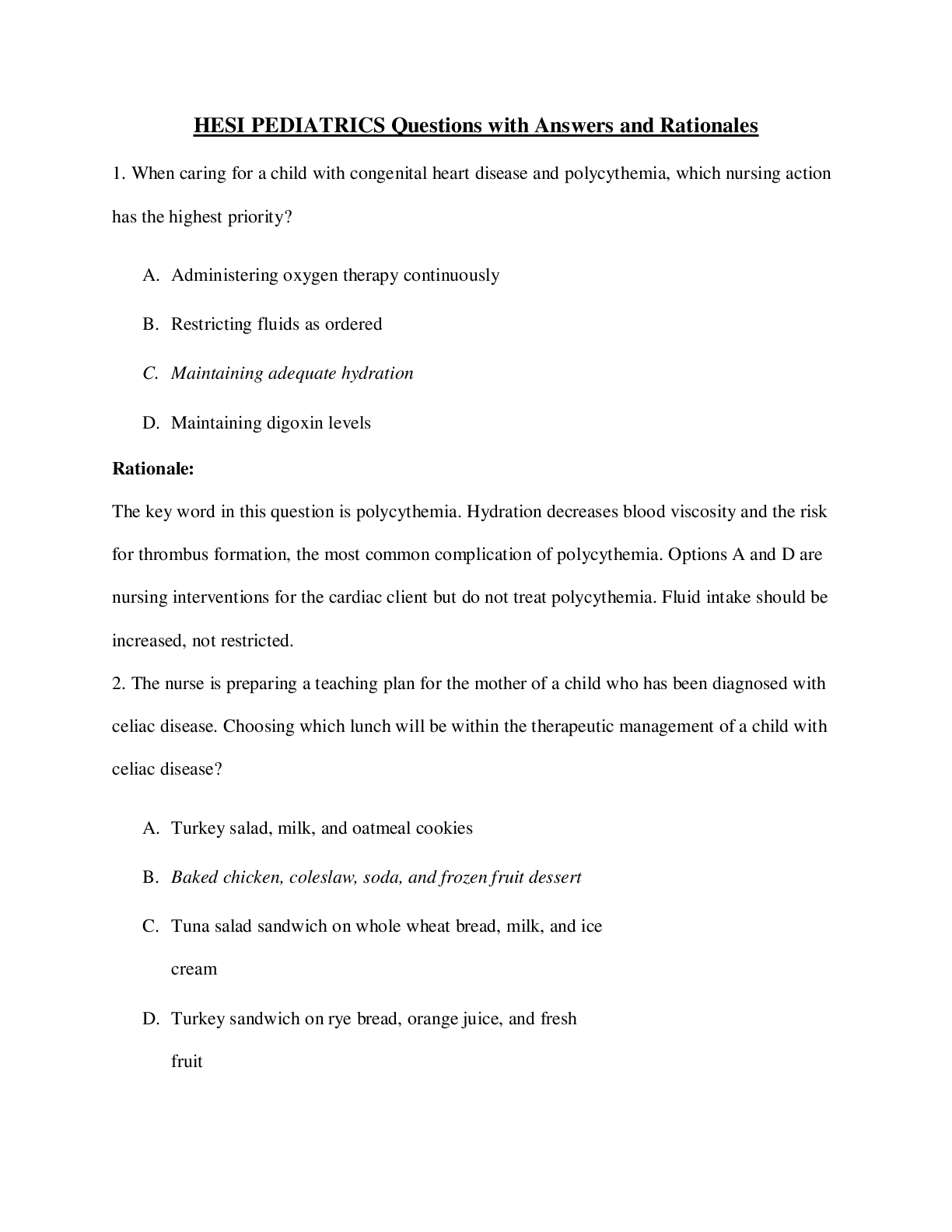Hesi Fundamentals Practice QUESTIONS AND ANSWERS 2021 GRADED A
Document Content and Description Below
Hesi Fundamentals Practice Which drug does a nurse anticipate may be prescribed to produce diuresis and inhibit formation of aqueous humor for a client with glaucoma? Chlorothiazide (Diuril) Aceta... zolamide (Diamox) Bendroflumethiazide (Naturetin) Demecarium bromide (Humorsol) A client receiving steroid therapy states, "I have difficulty controlling my temper which is so unlike me, and I don't know why this is happening." What is the nurse's best response? Tell the client it is nothing to worry about. Talk with the client further to identify the specific cause of the problem. Instruct the client to attempt to avoid situations that cause irritation. Interview the client to determine whether other mood swings are being experienced. A client receiving steroid therapy states, "I have difficulty controlling my temper which is so unlike me, and I don't know why this is happening." What is the nurse's best response? Tell the client it is nothing to worry about. Talk with the client further to identify the specific cause of the problem. Instruct the client to attempt to avoid situations that cause irritation. Interview the client to determine whether other mood swings are being experienced. The nurse is caring for a client with a temperature of 104.5 degrees Fahrenheit. The nurse applies a cooling blanket and administers an antipyretic medication. The nurse explains that the rationale for these interventions is to: Promote equalization of osmotic pressures. Prevent hypoxia associated with diaphoresis. Promote integrity of intracerebral neurons. Reduce brain metabolism and limit hypoxia. A health care provider prescribes 500 mg of an antibiotic intravenous piggyback (IVPB) every 12 hours. The vial of antibiotic contains 1 g and indicates that the addition of 2.5 mL of sterile water will yield 3 mL of reconstituted solution. How many milliliters of the antibiotic should be added to the 50 mL IVPB bag? Record your answer using one decimal place. __ mL 1.5 The nurse is caring for a non-ambulatory client with a reddened sacrum that is unrelieved by repositioning. What nursing diagnosis should be included on the client's plan of care? Risk for pressure ulcer Risk for impaired skin integrity Impaired skin integrity, related to infrequent turning and repositioning Impaired skin integrity, related to the effects of pressure and shearing force 1 A client has a pressure ulcer that is full thickness with necrosis into the subcutaneous tissue down to the underlying fascia. The nurse should document the assessment finding as which stage of pressure ulcer? Stage I Stage II Stage III Unstageable A pressure ulcer with necrotic tissue is unstageable. The necrotic tissue must be removed before the wound can be staged. A stage I pressure ulcer is defined as an area of persistent redness with no break in skin integrity. A stage II pressure ulcer is a partial-thickness wound with skin loss involving the epidermis, dermis, or both; the ulcer is superficial and may present as an abrasion, blister, or shallow crater. A stage III pressure ulcer involves full thickness tissue loss with visible subcutaneous fat. Bone, tendon, and muscle are not exposed. A client is being admitted for a total hip replacement. When is it necessary for the nurse to ensure that a medication reconciliation is completed? Select all that apply. After reporting severe pain On admission to the hospital Upon entering the operating room Before transfer to a rehabilitation facility At time of scheduling for the surgical procedure Medication reconciliation involves the creation of a list of all medications the client is taking and comparing it to the health care provider's prescriptions on admission or when there is a transfer to a different setting or service, or discharge. A change in status does not require medication reconciliation. A medication reconciliation should be completed long before entering the operating room. Total hip replacement is elective surgery, and scheduling takes place before admission; medication reconciliation takes place when the client is admitted. A client is taking lithium sodium (Lithium). The nurse should notify the health care provider for which of the following laboratory values? White blood cell (WBC) count of 15,000 mm3 Negative protein in the urine Blood urea nitrogen (BUN) of 20 mg/dL Prothrombin of 12.0 seconds White cell counts can increase with this drug. The expected range of the WBC count is 5000 to 10,000 mm3 for a healthy adult. Urinalysis, BUN, and prothrombin are not necessary and these are normal values. Often when a family member is dying, the client and the family are at different stages of grieving. During which stage of a client's grieving is the family likely to require more emotional nursing care than the client? Anger Denial 2 Depression Acceptance In the stage of acceptance, the client frequently detaches from the environment and may become indifferent to family members. In addition, the family may take longer to accept the inevitable death than does the client. Although the family may not understand the anger, dealing with the resultant behavior may serve as a diversion. Denial often is exhibited by the client and family members at the same time. During depression, the family often is able to offer emotional support, which meets their needs. The client asks the nurse to recommend foods that might be included in a diet for diverticular disease. Which foods would be appropriate to include in the teaching plan? Select all that apply. Whole grains Cooked fruit and vegetables Nuts and seeds Lean red meats Milk and eggs With diverticular disease the patient should avoid foods that may obstruct the diverticuli. Therefore the fiber should be digestible, such as whole grains, and cooked fruits and vegetables. Milk and eggs have no fiber content but are good sources of protein. In clients with diverticular disease, nuts and seeds are contraindicated as they may be retained and cause inflammation and infection, which is known as diverticulitis. The client should also decrease intake of fats and red meats. A nurse is obtaining a health history from the newly admitted client who has chronic pain in the knee. What should the nurse include in the pain assessment? Select all that apply. Pain history, including location, intensity, and quality of pain Client's purposeful body movement in arranging the papers on the bedside table Pain pattern, including precipitating and alleviating factors Vital signs such as increased blood pressure and heart rate The client's family statement about increases in pain with ambulation Accurate pain assessment includes pain history with the client's identification of pain location, intensity, and quality and helps the nurse to identify what pain means to the client. The pattern of pain includes time of onset, duration, and recurrence of pain and its assessment helps the nurse anticipate and meet the needs of the client. Assessment of the precipitating factors helps the nurse prevent the pain and determine it cause. Purposeless movements such as tossing and turning or involuntary movements such as a reflexive jerking may indicate pain. Physiological responses such as elevated blood pressure and heart rate are most likely to be absent in the client with chronic pain. Pain is a subjective experience and therefore the nurse has to ask the client directly instead of accepting statement of the family members. While undergoing a soapsuds enema, the client reports abdominal cramping. What action should the nurse take? 3 Immediately stop the infusion. Lower the height of the enema bag. Advance the enema tubing 2 to 3 inches. Clamp the tube for 2 minutes, then restart the infusion. Abdominal cramping during a soapsuds enema may be due to too rapid administration of the enema solution. Lowering the height of the enema bag slows the flow and allows the bowel time to adapt to the distention without causing excessive discomfort. Stopping the infusion is not necessary. Advancing the enema tubing is not appropriate. Clamping the tube for several minutes then restarting the infusion may be attempted if slowing the infusion does not relieve the cramps. During the initial physical assessment of a newly admitted client with a pressure ulcer, a nurse observes that the client's skin is dry and scaly. The nurse applies emollients and reinforces the dressing on the pressure ulcer. Legally, were the nurse's actions adequate? The nurse also should have instituted a plan to increase activity. The nurse provided supportive nursing care for the well-being of the client. Debridement of the pressure ulcer should have been done before the dressing was applied Treatment should not have been instituted until the health care provider's prescriptions were received. According to the Nurse Practice Act, a nurse may independently treat human responses to actual or potential health problems. An activity level is prescribed by a health care provider; this is a dependent function of the nurse. There is not enough information to come to the conclusion that debridement should have been done before the dressing was applied. Application of an emollient and reinforcing a dressing are independent nursing functions. A visitor comes to the nursing station and tells the nurse that a client and his relative had a fight and that the client is now lying unconscious on the floor. What is the most important action the nurse needs to take? Ask the client if he is okay. Call security from the room. Find out if there is anyone else in the room. Ask security to make sure the room is safe Safety is the first priority when responding to a presumably violent situation. The nurse needs to have security enter the room to ensure it is safe. Then it can be determined if the client is okay and make sure that any other people in the room are safe To ensure the safety of a client who is receiving a continuous intravenous normal saline infusion, the nurse should change the administration set every: 4 to 8 hours 12 to 24 hours 24 to 48 hours 72 to 96 hours Best practice guidelines recommend replacing administration sets no more frequently than 72 to 96 4 hours after initiation of use in patients not receiving blood, blood products, or fat emulsions. This evidence-based practice is safe and cost effective. Changing the administration set every 4 to 48 hours is not a cost-effective practice A nurse is taking care of a client who has severe back pain as a result of a work injury. What nursing considerations should be made when determining the client's plan of care? Select all that apply. Ask the client what is the client's acceptable level of pain. Eliminate all activities that precipitate the pain. Administer the pain medications regularly around the clock. Use a different pain scale each time to promote patient education. Assess the client's pain every 15 minutes The nurse works together with the client in order to determine the tolerable level of pain. Considering that the client has chronic, not acute pain, the goal of the pain management is to decrease pain to the tolerable level instead of eliminating pain completely. Administration of pain medications around the clock will provide the stable level of pain medication in the blood and relieve the pain. Elimination of all activities that precipitate the client's pain is not possible even though the nurse will try to minimize such activities. The same pain scale should be used for assessment of the client's pain level helps to ensure consistency and accuracy in the pain assessment. Only management of acute pain such as postoperative pain requires the pain assessment at frequent intervals. The nurse is preparing to administer eardrops to a client that has impacted cerumen. Before administering the drops, the nurse will assess the client for which contraindications? Select all that apply. Allergy to the medication Itching in the ear canal Drainage from the ear canal Tympanic membrane rupture Partial hearing loss in the affected ear Contraindications to eardrops include allergy to the medication, drainage from the ear canal, and tympanic membrane rupture. Partial hearing loss may occur with impacted cerumen and is not a contraindication to the use of eardrops. Itching may occur with some ear conditions and is not a contraindication to the use of eardrops. What clinical indicators should the nurse expect a client with hyperkalemia to exhibit? Select all that apply. Tetany Seizures Diarrhea Weakness Dysrhythmias Tetany is caused by hypocalcemia. Seizures caused by electrolyte imbalances are associated with 5 low calcium or sodium levels. Because of potassium's role in the sodium/potassium pump, hyperkalemia will cause diarrhea, weakness, and cardiac dysrhythmias. A health care provider has prescribed isoniazid (Laniazid) for a client. Which instruction should the nurse give the client about this medication? Prolonged use can cause dark concentrated urine. The medication is best absorbed when taken on an empty stomach. Take the medication with aluminum hydroxide to minimize GI upset. Drinking alcohol daily can cause drug-induced hepatitis Daily alcohol intake can cause drug induced hepatitis. Prolonged use does not cause dark concentrated urine. The client should take isoniazid with meals to decrease GI upset. Clients should avoid taking aluminum antacids at the same time as this medication because it impairs absorption. To minimize the side effects of the vincristine (Oncovin) that a client is receiving, what does the nurse expect the dietary plan to include? Low in fat High in iron High in fluids Low in residue A common side effect of vincristine is a paralytic ileus that results in constipation. Preventative measures include high-fiber foods and fluids that exceed minimum requirements. These will keep the stool bulky and soft, thereby promoting evacuation. Low in fat, high in iron, and low in residue dietary plans will not provide the roughage and fluids needed to minimize the constipation associated with vincristine. A postoperative client says to the nurse, "My neighbor, I mean the person in the next room, sings all night and keeps me awake." The neighboring client has dementia and is awaiting transfer to a nursing home. How can the nurse best handle this situation? Tell the neighboring client to stop singing. Close the doors to both clients' rooms at night. Give the complaining client the prescribed as needed sedative. Move the neighboring client to a room at the end of the hall Moving the client who is singing away from the other clients diminishes the disturbance. A client with dementia will not remember instructions. It is unsafe to close the doors of clients' rooms because they need to be monitored. The use of a sedative should not be the initial intervention The nurse is providing postoperative care to a client who had a submucosal resection (SMR) for a deviated septum. The nurse should monitor for what complication associated with this type of surgery? Occipital headache Periorbital crepitus Expectoration of blood Changes in vocalization 6 After an SMR, hemorrhage from the area should be suspected if the client is swallowing frequently or expelling blood with saliva. A headache in the back of the head is not a complication of a submucosal resection. Crepitus is caused by leakage of air into tissue spaces; it is not an expected complication of SMR. The nerves and structures involved with speech are not within the operative area. However, the sound of the voice is altered temporarily by the presence of nasal packing and edema. A nurse is reviewing a plan of care for a client who was admitted with dehydration as a result of prolonged watery diarrhea. Which prescription should the nurse question? Oral psyllium (Metamucil) Oral potassium supplement Parenteral half normal saline Parenteral albumin (Albuminar) Albumin is hypertonic and will draw additional fluid from the tissues into the intravascular space. Oral psyllium will absorb the watery diarrhea, giving more bulk to the stool. An oral potassium supplement is appropriate because diarrhea causes potassium loss. Parenteral half normal saline is a hypotonic solution, which can correct dehydration. A client is to have mafenide (Sulfamylon) cream applied to burned areas. For which serious side effect of mafenide therapy should the nurse monitor this client? Curling ulcer Renal shutdown Metabolic acidosis Hemolysis of red blood cells Mafenide interferes with the kidneys' role in hydrogen ion excretion, resulting in metabolic acidosis. Curling ulcer, renal shutdown, and hemolysis of red blood cells are not adverse effects of the drugs. A nurse is preparing to administer an ophthalmic medication to a client. What techniques should the nurse use for this procedure? Select all that apply. Clean the eyelid and eyelashes. Place the dropper against the eyelid. Apply clean gloves before beginning of procedure. Instill the solution directly onto cornea. Press on the nasolacrimal duct after instilling the solution. Cleaning of the eyelids and eyelashes helps to prevent contamination of the other eye and lacrimal duct. Application of gloves helps to prevent direct contact of the nurse with the client's body fluids. Applying pressure to the nasolacrimal duct prevents the medication from running out of the eye. The dropper should not touch the eyelids or eyelashes in order to prevent contamination of the medication in the dropper. The medication should not be instilled directly onto the cornea because cornea has many pain fibers and is therefore very sensitive. The medication is to be instilled into the lower conjunctival sac. The nurse recognizes that which are important components of a neurovascular assessment? Select all that apply. 7 Orientation Capillary refill Pupillary response Respiratory rate Pulse and skin temperature Movement and sensation A neurovascular assessment involves evaluation of nerve and blood supply to an extremity involved in an injury. The area involved may include an orthopedic and/or soft tissue injury. A correct neurovascular assessment should include evaluation of capillary refill, pulses, warmth and paresthesias, and movement and sensation. Orientation, pupillary response, and respiratory rate are components of a neurological assessment. A client reaches the point of acceptance during the stages of dying. What response should the nurse expect the client to exhibit? Apathy Euphoria Detachment Emotionalism When an individual reaches the point of being intellectually and psychologically able to accept death, anxiety is reduced and the individual becomes detached from the environment. Although detached, the client is not apathetic but still may be concerned and use time constructively. Although resigned to death, the individual is not euphoric. In the stage of acceptance, the client is no longer angry or depressed. A dying client is coping with feelings regarding impending death. The nurse bases care on the theory of death and dying by Kübler-Ross. During which stage of grieving should the nurse primarily use nonverbal interventions? Anger Denial Bargaining Acceptance Communication and interventions during the acceptance stage are mainly nonverbal (e.g., holding the client's hand). The nurse should be quiet but available. During the anger stage the nurse should accept that the client is angry. The anger stage requires verbal communication. During the denial stage the nurse should accept the client's behavior but not reinforce the denial. The denial stage requires verbal communication. During the bargaining stage the nurse should listen intently but not provide false reassurance. The bargaining stage requires verbal communication. When a client files a lawsuit against a nurse for malpractice, the client must prove that there is a link between the harm suffered and actions performed by the nurse that were negligent. This is known as: Evidence Tort discovery 8 Proximate cause Common cause Proximate cause is the legal concept meaning that the client must prove that the nurse's actions contributed to or caused the client's injury. Evidence is data presented in proof of the facts, which may include witness testimony, records, documents, or objects. A tort is a wrongful act, not including a breach of contract of trust that results in injury to another person. Common cause means to unite one's interest with another's. Following a surgery on the neck, the client asks the nurse why the head of the bed is up so high. The nurse should tell the client that the high-Fowler position is preferred for what reason? To avoid strain on the incision To promote drainage of the wound To provide stimulation for the client To reduce edema at the operative site This position prevents fluid accumulation in the tissue, thereby minimizing edema. This position will neither increase nor decrease strain on the suture line. Drainage from the wound will not be affected by this position. This position will not affect the degree of stimulation. The nurse is preparing discharge instructions for a client who has begun to demonstrate signs of early Alzheimer dementia. The client lives alone. The client's adult children live nearby. According to the prescribed medication regimen the client is to take medications six times throughout the day. What is the priority nursing intervention to assist the client with taking the medication? Contact the client's children and ask them to hire a private duty aide who will provide round-the-clock care. Develop a chart for the client, listing the times the medication should be taken. Contact the primary health care provider and discuss the possibility of simplifying the medication regimen. Instruct the client and client's children to put medications in a weekly pill organizer Contacting a medical care provider and discussing the possibility of simplifying the client's medication regimen will make it possible to use a weekly pill organizer : an empty pill box will remind the client who has a short-term memory deficit due to Alzheimer dementia that medication was taken and will prevent medication being taken multiple times. The client does not require 24-hour supervision because the client is in the outset of the Alzheimer dementia and the major issue is a short-term memory loss. A chart may be complex and difficult to understand for the client and will require the client to perform cognitive tasks multiple times on daily basis that may be beyond the client's ability. Use of the weekly pill organizers will be difficult with the current medication regimen when the client has to take medications six times a day; the medication regimen has to be simplified first. The nurse expects a client with an elevated temperature to exhibit what indicators of pyrexia? Select all that apply. Dyspnea Flushed face 9 Precordial pain Increased pulse rate Increased blood pressure Increased body heat dilates blood vessels, causing a flushed face. The pulse rate increases to meet increased tissue demands for oxygen in the febrile state. Fever may not cause difficult breathing. Pain is not related to fever. Blood pressure is not expected to increase with fever. The nurse should instruct a client with an ileal conduit to empty the collection device frequently because a full urine collection bag may: Force urine to back up into the kidneys. Suppress production of urine. Cause the device to pull away from the skin. Tear the ileal conduit If the device becomes full and is not emptied, it may pull away from the skin and leak urine. Urine in contact with unprotected skin will irritate and cause skin breakdown. A full urine collection bag will not cause urine to back up into the kidneys, suppress the production of urine, or tear the ileal conduit. The triage nurse in the emergency department receives four clients simultaneously. Which of the clients should the nurse determine can be treated last? Multipara in active labor Middle-aged woman with substernal chest pain Older adult male with a partially amputated finger Adolescent boy with an oxygen saturation of 91% Although a client with a partially amputated finger needs control of bleeding, the injury is not life threatening and the client can wait for care. A woman in active labor should be assessed immediately because birth may be imminent. A woman with chest pain may be experiencing a life-threatening illness and should be assessed immediately. An adolescent with significant hypoxia may be experiencing a life-threatening illness and should be assessed immediately. Health promotion efforts with the chronically ill client should include interventions related to primary prevention. What should this include? Encouraging daily physical exercise Performing yearly physical examinations Providing hypertension screening programs Teaching a person with diabetes how to prevent complications Primary prevention activities are directed toward promoting healthful lifestyles and increasing the level of well-being. Performing yearly physical examinations is a secondary prevention. Emphasis is on early detection of disease, prompt intervention, and health maintenance for those experiencing health problems. Providing hypertension screening programs is a secondary prevention. Emphasis is on early detection of disease, prompt intervention, and health maintenance for those experiencing health problems. Teaching a person with diabetes how to prevent complications is a tertiary 10 prevention. Emphasis is on rehabilitating individuals and restoring them to an optimum level of functioning. A nurse who is working on a medical-surgical unit receives a phone call requesting information about a client who has undergone surgery. The nurse observes that the client requested a do not publish (DNP) order on any information regarding condition or presence in the hospital. What is the best response by the nurse? "We have no record of that client on our unit. Thank you for calling." "The new privacy laws prevent me from providing any client information over the phone." "The client has requested that no information be given out. You'll need to call the client directly." "It is against the hospital's policy to provide you with any information regarding any of our clients." The response "We have no record of that client on our unit. Thank you for calling." conforms to the request that no information be given regarding the client's condition or presence in the hospital. HIPAA laws do not prohibit the provision of information to others as long as the client consents. The response "The client has requested that no information be given out. You'll need to call the client directly." implies that the client is admitted to the facility; this violates the client's request that no information should be shared with others. Hospital policies do not prohibit the provision of information to others as long as the client consents. The response "It is against the hospital's policy to provide you with any information regarding any of our clients." also implies that the client is admitted to the facility. When being interviewed for a position as a registered professional nurse, the applicant is asked to identify an example of an intentional tort. What is the appropriate response? Negligence Malpractice Breach of duty False imprisonment False imprisonment is a wrong committed by one person against another in a willful, intentional way without just cause or excuse. Negligence is an unintentional tort. Malpractice, which is professional negligence, is classified as an unintentional tort. Breach of duty is an unintentional tort. The nurse plans care for a client with a somatoform disorder based on the understanding that the disorder is: A physiological response to stress A conscious defense against anxiety An intentional attempt to gain attention An unconscious means of reducing stress When emotional stress overwhelms an individual's ability to cope, the unconscious seeks to reduce stress. A conversion reaction removes the client from the stressful situation, and the conversion reaction's physical/sensory manifestation causes little or no anxiety in the individual. This lack of concern is called la belle indifference. No physiologic changes are involved with this unconscious resolution of a conflict. The conversion of anxiety to physical symptoms operates on an unconscious level. 11 A nurse is caring for a client diagnosed with methicillin-resistant Staphylococcus aureus (MRSA) in the urine. The health care provider orders an indwelling urinary catheter to be inserted. Which precaution should the nurse take during this procedure? Droplet precautions Reverse isolation Surgical asepsis Medical asepsis Catheter insertion requires the procedure to be performed under sterile technique. Droplet precautions are used with certain respiratory illnesses. Reverse isolation is used with clients who may be immunocompromised. Medical asepsis involves clean technique/gloving. . A nurse is teaching an adolescent about type 1 diabetes and self-care. Which questions from the client indicate a need for additional teaching in the cognitive domain? Select all that apply. "What is diabetes?" "What will my friends think?" "How do I give myself an injection?" "Can you tell me how the glucose monitor works?" "How do I get the insulin from the vial into the syringe? Acquiring knowledge or understanding aids in developing concepts, rather than skills or attitudes, and is a basic learning task in the cognitive domain. Values and self-realization are in the affective domain. Skills acquisition is in the psychomotor domain. Place each step of the nursing process in the order that it should be used. Obtain client's nursing history. State client's nursing needs. Identify goals for care. Develop a plan of care. Implement nursing interventions. First the nurse should gather data. Based on the data, the client's needs are assessed. After the needs have been determined, the goals for care are established. The next step is planning care based on the knowledge gained from the previous steps. Implementation follows the development of the plan of care. In what position should the nurse place a client recovering from general anesthesia? Supine Side-lying High Fowler Trendelenburg Turning the client to the side promotes drainage of secretions and prevents aspiration, especially when the gag reflex is not intact. This position also brings the tongue forward, preventing it from occluding the airway when it is in the relaxed state. The risk for aspiration is increased when the supine position is assumed by a semi-alert client. High Fowler position may cause the neck to flex in 12 a client who is not alert, interfering with respirations. Trendelenburg position is not used for a postoperative client because it interferes with breathing. Which age-related change should the nurse consider when formulating a plan of care for an older adult? Select all that apply. Difficulty in swallowing Increased sensitivity to heat Increased sensitivity to glare Diminished sensation of pain Heightened response to stimuli Changes in the ciliary muscles, decrease in pupil size, and a more rigid pupil sphincter contribute to an increased sensitivity to glare. Diminished sensation of pain may make an older individual unaware of a serious illness, thermal extremes, or excessive pressure. There should be no interference with swallowing in older individuals. Older individuals tend to feel the cold and rarely complain of the heat. There is a decreased response to stimuli in the older individual The spouse of a comatose client who has severe internal bleeding refuses to allow transfusions of whole blood because they are Jehovah's Witnesses. The client does not have a Durable Power of Attorney for Healthcare. What action should the nurse take? Institute the prescribed blood transfusion because the client's survival depends on volume replacement. Clarify the reason why the transfusion is necessary and explain the implications if there is no transfusion. Phone the health care provider for an administrative prescription to give the transfusion under these circumstances. Give the spouse a treatment refusal form to sign and notify the health care provider that a court order now can be sought The client is unconscious. Although the spouse can give consent, there is no legal power to refuse a treatment for the client unless previously authorized to do so by a power of attorney or a health care proxy; the court can make a decision for the client. Explanations will not be effective at this time and will not meet the client's needs. Instituting the prescribed blood transfusion and phoning the health care provider for an administrative prescription are without legal basis, and the nurse may be held liable. Twenty-four hours after a cesarean birth, a client elects to sign herself and her baby out of the hospital. Staff members are unable to contact her health care provider. The client arrives at the nursery and asks that her infant be given to her to take home. What is the most appropriate nursing action? Give the infant to the client and instruct her regarding the infant's care Explain to the client that she can leave, but her infant must remain in the hospital. Emphasize to the client that the infant is a minor and legally must remain until prescriptions are received. Tell the client that hospital policy prevents the staff from releasing the infant until ready for discharge When a client signs herself and her infant out of the hospital, she is legally responsible for her infant. The infant is the responsibility of the mother and can leave with the mother when she signs them out. 13 A client reports fatigue and dyspnea and appears pale. The nurse questions the client about medications currently being taken. In light of the symptoms, which medication causes the nurse to be most concerned? Famotidine (Pepcid) Methyldopa (Aldomet) Ferrous sulfate (Feosol) Levothyroxine (Synthroid) Methyldopa is associated with acquired hemolytic anemia and should be discontinued to prevent progression and complications. Famotidine will not cause these symptoms; it decreases gastric acid secretion, which will decrease the risk of gastrointestinal bleeding. Ferrous sulfate is an iron supplement to correct, not cause, symptoms of anemia. Levothyroxine is not associated with red blood cell destruction. The nurse assesses a client's pulse and documents the strength of the pulse as 3+. The nurse understands that this indicates the pulse is: faint, barely detectable. slightly weak, palpable. normal. bounding. The strength of a pulse is a measurement of the force at which blood is ejected against the arterial wall. Palpation should be done using the fingertips and intensity of the pulse graded on a scale of 0 to 4 + with 0 indicating no palpable pulse, 1 + indicating a faint, but detectable pulse, 2 + suggesting a slightly more diminished pulse than normal, 3 + is a normal pulse, and 4 + indicating a bounding pulse. A toddler screams and cries noisily after parental visits, disturbing all the other children. When the crying is particularly loud and prolonged, the nurse puts the crib in a separate room and closes the door. The toddler is left there until the crying ceases, a matter of 30 or 45 minutes. Legally, how should this behavior be interpreted? Limits had to be set to control the child's crying. The child had a right to remain in the room with the other children. The child had to be removed because the other children needed to be considered. Segregation of the child for more than half an hour was too long a period of time Legally, a person cannot be locked in a room (isolated) unless there is a threat of danger either to the self or to others. Limit setting in this situation is not warranted. This is a reaction to separation from the parent, which is common at this age. Crying, although irritating, will not harm the other children. A child should never be isolated An older client who is receiving chemotherapy for cancer has severe nausea and vomiting and becomes dehydrated. The client is admitted to the hospital for rehydration therapy. Which interventions have specific gerontologic implications the nurse must consider? Select all that apply. Assessment of skin turgor 14 Documentation of vital sign Assessment of intake and output Administration of antiemetic drugs Replacement of fluid and electrolytes When skin turgor is assessed, the presence of tenting may be related to loss of subcutaneous tissue associated with aging rather than to dehydration; skin over the sternum should be used instead of skin on the arm for checking turgor. Older adults are susceptible to central nervous system side effects, such as confusion, associated with antiemetic drugs; dosages must be reduced, and responses must be evaluated closely. Because many older adults have delicate fluid balance and may have cardiac and renal disease, replacement of fluid and electrolytes may result in adverse consequences, such as hypervolemia, pulmonary edema, and electrolyte imbalance. Vital signs can be obtained as with any other adult. Intake and output can be measured accurately in older adults. What should the nurse consider when obtaining an informed consent from a 17-year-old adolescent? If the client is allowed to give consent The client cannot make informed decisions about health care. If the client is permitted to give voluntary consent when parents are not available. The client probably will be unable to choose between alternatives when asked to consent. A person is legally unable to sign a consent until the age of 18 years unless the client is an emancipated minor or married. The nurse must determine the legal status of the adolescent. Although the adolescent may be capable of intelligent choices, 18 is the legal age of consent unless the client is emancipated or married. Parents or guardians are legally responsible under all circumstances unless the adolescent is an emancipated minor or married. Adolescents have the capacity to choose, but not the legal right in this situation unless they are legally emancipated or married. An 85-year-old client has just been admitted to a nursing home. When designing a plan of care for this older adult the nurse recalls what expected sensory losses associated with aging? Select all that apply. Difficulty in swallowing Diminished sensation of pain Heightened response to stimuli Impaired hearing of high-frequency sounds Increased ability to tolerate environmental heat Because of aging of the nervous system an older adult has a diminished sensation of pain and may be unaware of a serious illness, thermal extremes, or excessive pressure. As people age they experience atrophy of the organ of Corti and cochlear neurons, loss of the sensory hair cells, and degeneration of the stria vascularis, which affects an older person's ability to perceive high-frequency sounds. An interference with swallowing is a motor, not a sensory, loss, nor is it an expected response to aging. There is a decreased, not heightened, response to stimuli in older adults. There is a decreased, not increased, ability to physiologically adjust to extremes in environmental temperature. 15 A nurse receives a subpoena in a court case involving a child. The nurse is preparing to appear in court. In addition to the state Nurse Practice Act and the American Nursing Association (ANA) Code for Nurses, what else should the nurse review? Nursing's Social Policy Statement State law regarding protection of minors ANA Standards of Clinical Nursing Practice References regarding a child's right to consent The ANA Standards of Clinical Nursing Practice guidelines govern safe nursing practice; nurses are legally responsible to perform according to these guidelines. Nursing's Social Policy Statement explains what the public can expect from nurses, but it is not used to govern nursing practice. There are no data that indicate state law regarding protection of minors and references regarding a child's right to consent are necessary. A client is receiving albuterol (Proventil) to relieve severe asthma. For which clinical indicators should the nurse monitor the client? Select all that apply. Tremors Lethargy Palpitations Visual disturbances Decreased pulse rate Albuterol's sympathomimetic effect causes central nervous stimulation, precipitating tremors, restlessness, and anxiety. Albuterol's sympathomimetic effect causes cardiac stimulation that may result in tachycardia and palpitations. Albuterol may cause restlessness, irritability, and tremors, not lethargy. Albuterol may cause dizziness, not visual disturbances. Albuterol will cause tachycardia, not bradycardia. A client asks about the purpose of a pulse oximeter. The nurse explains that it is used to measure the: Respiratory rate. Amount of oxygen in the blood. Percentage of hemoglobin-carrying oxygen. Amount of carbon dioxide in the blood The pulse oximeter measures the oxygen saturation of blood by determining the percentage of hemoglobin-carrying oxygen. A pulse oximeter does not interpret the amount of oxygen or carbon dioxide carried in the blood, nor does it measure respiratory rate. A client comes to the clinic complaining of a productive cough with copious yellow sputum, fever, and chills for the past two days. The first thing the nurse should do when caring for this client is to: Encourage fluids. Administer oxygen. Take the temperature. Collect a sputum specimen 16 Baseline vital signs are extremely important; physical assessment precedes diagnostic measures and intervention. This is done after the health care provider makes a medical diagnosis; this is not an independent function of the nurse. Encouraging fluids might be done after it is determined whether a specimen for blood gases is needed; this is not usually an independent function of the nurse. Oxygen is administered independently by the nurse only in an emergency situation. A sputum specimen should be obtained after vital signs and before administration of antibiotics. A nurse is preparing a community health program for senior citizens. The nurse teaches the group that the physical findings that are typical in older people include: A loss of skin elasticity and a decrease in libid Impaired fat digestion and increased salivary secretions Increased blood pressure and decreased hormone production An increase in body warmth and some swallowing difficulties With aging, narrowing of the arteries causes some increase in the systolic and diastolic blood pressures; hormone production decreases after menopause. There may or may not be changes in libido; there is a loss of skin elasticity. Salivary secretions decrease, not increase, causing more difficulty with swallowing; there is some impairment of fat digestion. There may be a decrease in subcutaneous fat and decreasing body warmth; some swallowing difficulties occur because of decreased oral secretions. A client has been diagnosed as brain dead. The nurse understands that this means that the client has: No spontaneous reflexes Shallow and slow breathing No cortical functioning with some reflex breathing Deep tendon reflexes only and no independent breathing A client who is declared as being brain dead has no function of the cerebral cortex and a flat EEG. The client may have some spontaneous breathing and a heartbeat. The guidelines established by the American Association of Neurology include coma or unresponsiveness, absence of brainstem reflexes, and apnea. There are specific assessments to validate the findings. The other answer options do not fit the definition of brain dead. A nurse cares for a client that has been bitten by a large dog. A bite by a large dog can cause which type of trauma? Abrasion Fracture Crush injury Incisional laceration The bite of a large dog can exert between 150 and 400 psi of pressure, causing a crush injury. A crush injury may or may not include a fracture. Abrasions and incisional lacerations are not caused by this form of trauma. 17 A client who was exposed to hepatitis A asks why an injection of gamma globulin is needed. Before responding, what should the nurse consider about how gamma globulin provides passive immunity? It increases production of short-lived antibodies. It accelerates antigen-antibody union at the hepatic sites. The lymphatic system is stimulated to produce antibodies. The antigen is neutralized by the antibodies that it supplies Gamma globulin, which is an immune globulin, contains most of the antibodies circulating in the blood. When injected into an individual, it prevents a specific antigen from entering a host cell. Gamma globulin does not stimulate antibody production. It does not affect antigen-antibody function. A nurse is caring for a client with an impaired immune system. Which blood protein associated with the immune system is important for the nurse to consider? Albumin Globulin Thrombin Hemoglobin The gamma-globulin fraction in the plasma is the fraction that includes the antibodies. Albumin helps regulate fluid shifts by maintaining plasma oncotic pressure. Thrombin is involved with clotting. Hemoglobin carries oxygen. A nurse discusses the philosophy of Alcoholics Anonymous (AA) with the client who has a history of alcoholism. What need must self-help groups such as AA meet to be successful? Trust Growth Belonging Independence Self-help groups are successful because they support a basic human need for acceptance. A feeling of comfort and safety and a sense of belonging may be achieved in a nonjudgmental, supportive, sharing experience with others. AA meets dependency needs rather than focusing on independence, trust, and growth. What type of interview is most appropriate when a nurse admits a client to a clinic? Directive Exploratory Problem solving Information giving The first step in the problem-solving process is data collection so that client needs can be identified. During the initial interview a direct approach obtains specific information, such as allergies, current medications, and health history. The exploratory approach is too broad because in a nondirective interview the client controls the subject matter. Problem solving and information giving are premature at the initial visit. 18 What is a basic concept associated with rehabilitation that the nurse should consider when formulating discharge plans for clients? Rehabilitation needs are met best by the client's family and community resources. Rehabilitation is a specialty area with unique methods for meeting clients' needs. Immediate or potential rehabilitation needs are exhibited by clients with health problems. Clients who are returning to their usual activities following hospitalization do not require rehabilitation. Rehabilitation refers to a process that assists clients to obtain optimal functioning. Care should be initiated immediately when a health problem exists to avoid complications and facilitate recuperation. All resources that can be beneficial to client rehabilitation, including the private health care provider and acute care facilities, should be used. Rehabilitation is a commonality in all areas of nursing practice. Rehabilitation is necessary to help clients return to a previous or optimal level of functioning. A client is admitted with severe diarrhea that resulted in hypokalemia. The nurse should monitor for what clinical manifestations of the electrolyte deficiency? Select all that apply. Diplopia Skin rash Leg cramps Tachycardia Muscle weakness Leg cramps occur with hypokalemia because of potassium deficit. Muscle weakness occurs with hypokalemia because of the alteration in the sodium potassium pump mechanism. Diplopia does not indicate an electrolyte deficit. A skin rash does not indicate an electrolyte deficit. Tachycardia is not associated with hypokalemia, bradycardia is. A nurse in the surgical intensive care unit is caring for a client with a large surgical incision. The nurse reviews a list of vitamins and expects that which medication will be prescribed because of its major role in wound healing? Vitamin A (Aquasol A) Cyanocobalamin (Cobex) Phytonadione (Mephyton) Ascorbic acid (Ascorbicap) Vitamin C (ascorbic acid) plays a major role in wound healing. It is necessary for the maintenance and formation of collagen, the major protein of most connective tissues. Vitamin A is important for the healing process; however, vitamin C is the priority because it cements the ground substance of supportive tissue. Cyanocobalamin is a vitamin B12 preparation needed for red blood cell synthesis and a healthy nervous system. Phytonadione is vitamin K, which plays a major role in blood coagulation. A client is receiving an intravenous (IV) infusion of 5% dextrose in water. The client loses weight and develops a negative nitrogen balance. The nurse concludes that what likely contributed to this client's weight loss? 19 Excessive carbohydrate intake Lack of protein supplementation Insufficient intake of water-soluble vitamins Increased concentration of electrolytes in cells An infusion of dextrose in water does not provide proteins required for tissue growth, repair, and maintenance; therefore, tissue breakdown occurs to supply the essential amino acids. Each liter provides approximately 170 calories, which is insufficient to meet minimal energy requirements; tissue breakdown will result. Weight loss is caused by insufficient nutrient intake; vitamins do not prevent weight loss. An infusion of 5% dextrose in water may decrease electrolyte concentration. A client has undergone a subtotal thyroidectomy. The client is being transferred from the post anesthesia care unit/recovery area to the inpatient nursing unit. What emergency equipment is most important for the nurse to have available for this client? A defibrillator An IV infusion pump A tracheostomy tray An electrocardiogram (ECG) monitor The client who has undergone a subtotal thyroidectomy is at high risk for airway occlusion resulting from postoperative edema. With this in mind, emergency airway equipment such as a tracheostomy set and intubation supplies should be immediately available to the client. A defibrillator, an IV infusion pump, and an electrocardiogram (ECG) monitor are all equipment items that should be available to all postoperative clients. The nurse reviews a medical record and is concerned that the client may develop hyperkalemia. Which disease increases the risk of hyperkalemia? Crohn's Cushing's End-stage renal Gastroesophageal reflux . One of the kidneys' functions is to eliminate potassium from the body; diseases of the kidneys often interfere with this function, and hyperkalemia may develop, necessitating dialysis. Clients with Crohn's disease have diarrhea, resulting in potassium loss. Clients with Cushing's disease will retain sodium and excrete potassium. Clients with gastroesophageal reflux disease are prone to vomiting that may lead to sodium and chloride loss with minimal loss of potassium A nurse assesses a client's serum electrolyte levels in the laboratory report. What electrolyte in intracellular fluid should the nurse consider most important? Sodium Calcium Chloride Potassium 20 The concentration of potassium is greater inside the cell and is important in establishing a membrane potential, a critical factor in the cell's ability to function. Sodium is the most abundant cation of the extracellular compartment, not the intracellular compartment. Calcium is the most abundant electrolyte in the body; 99% is concentrated in the teeth and bones, and only 1% is available for bodily functions. Chloride is an extracellular, not intracellular, anion. What is the maximum length of time a nurse should allow an intravenous (IV) bag of solution to infuse? 6 hours 12 hours 18 hours 24 hours After 24 hours there is increased risk for contamination of the solution and the bag should be changed. It is unnecessary to change the bag any less often. An intravenous piggyback (IVPB) of cefazolin (Kefzol) 500 mg in 50 mL of 5% dextrose in water is to be administered over a 20-minute period. The tubing has a drop factor of 15 drops/mL. At what rate per minute should the nurse regulate the infusion to run? Record the answer using a whole number. ______ gtts/min Solve the problem by using the following formula: Drops per minute = total number of drops / total time in minutes Drops per minute = 50 mL x 15 (drop factor) / 20 mintes = 750 / 20 = 37.5. Round the answer to 38 drops per minute. 38 Solve the problem by using the following formula: Drops per minute = total number of drops / total time in minutes Drops per minute = 50 mL x 15 (drop factor) / 20 mintes = 750 / 20 = 37.5. Round the answer to 38 drops per minute The nurse manager is planning to assign an unlicensed assistive personnel (UAP) to care for clients. What care can be delegated on a medical-surgical unit to a UAP? Select all that apply. Performing a bed bath for a client on bed rest Evaluating the effectiveness of acetaminophen and codeine (Tylenol #3) Obtaining an apical pulse rate before oral digoxin (Lanoxin) is administered Assisting a client who has patient-controlled analgesia (PCA) to the bathroom Assessing the wound integrity of a client recovering from an abdominal laparotomy Performing a bed bath for a client on bed rest is within the scope of practice of the UAP. Assisting a client who has PCA to the bathroom does not require professional nursing judgment and is within the job description of the UAP. Evaluating human responses to medications requires the expertise of a licensed professional nurse. Obtaining an apical pulse rate requires a professional nursing judgment to determine whether or not the medication should be administered. Evaluating human responses to health care interventions requires the expertise of a licensed professional nurse. A client has an anaphylactic reaction after receiving intravenous penicillin. What does the nurse conclude is the cause of this reaction? 21 An acquired atopic sensitization occurred. There was passive immunity to the penicillin allergen. Antibodies to penicillin developed after a previous exposure. Potent antibodies were produced when the infusion was instituted Hypersensitivity results from the production of antibodies in response to exposure to certain foreign substances (allergens). Earlier exposure is necessary for the development of these antibodies. This is not a sensitivity reaction to penicillin; hay fever and asthma are atopic conditions. It is an active, not passive, immune response. Antibodies developed when there was a previous, not current, exposure to penicillin. A nurse is providing care to a client eight hours after the client had surgery to correct an upper urinary tract obstruction. Which assessment finding should the nurse report to the surgeon? Incisional pain Absent bowel sounds Urine output of 20 mL/hour Serosanguineous drainage on the dressing A urinary output of 50 mL/hr or greater is necessary to prevent stasis and consequent infections after this type of surgery. The nurse should notify the surgeon of the assessment findings, since this may indicate a urinary tract obstruction. Incisional pain, absent bowel sounds, and serosanguineous drainage are acceptable assessment findings for this client after this procedure and require continued monitoring but do not necessarily require reporting to the surgeon A nurse is caring for an older adult who is taking acetaminophen (Tylenol) for the relief of chronic pain. Which substance is most important for the nurse to determine if the client is taking because it intensifies the most serious adverse effect of acetaminophen? Alcohol Caffeine Saw palmetto St. John's wort Too much ingestion of alcohol can cause scarring and fibrosis of the liver. Eighty-five to 95% of acetaminophen is metabolized by the liver. Acetaminophen and alcohol are both hepatotoxic substances. Metabolites of acetaminophen along with alcohol can cause irreversible liver damage. Caffeine affects (stimulates) the cardiovascular system, not the liver. In addition, caffeine does not interact with acetaminophen. Saw palmetto is not associated with increased liver damage when taking acetaminophen. It often is taken for benign prostatic hypertrophy because of its antiinflammatory and antiproliferative properties in prostate tissue. St. John's wort is classified as an antidepressant and is not associated with increased liver damage when taking acetaminophen. However, it does decrease the effectiveness of acetaminophen. An arterial blood gas report indicates the client's pH is 7.25, PCO2 is 35 mm Hg, and HCO3 is 20 mEq/L. Which disturbance should the nurse identify based on these results? 1 Metabolic acidosis 2 Metabolic alkalosis 22 3 Respiratory acidosis 4 Respiratory alkalosis A low pH and low bicarbonate level are consistent with metabolic acidosis. The pH indicates acidosis. The CO2 concentration is within normal limits, which is inconsistent with respiratory acidosis; it is elevated with respiratory acidosis. 1 A low pH and low bicarbonate level are consistent with metabolic acidosis. The pH indicates acidosis. The CO2 concentration is within normal limits, which is inconsistent with respiratory acidosis; it is elevated with respiratory acidosis. Ph-7.35-7.45 PCO2 - 35-45 HCO3 - 22-30 Toxicity can result because the action of calcium ions is similar to that of digoxin. Calcium gluconate cannot be added to a solution containing carbonate or phosphate because a dangerous precipitation will occur. Calcium gluconate can be added to the IV solution the client is receiving. If calcium infiltrates, sloughing of tissue will result. A nurse is preparing to administer an oil-retention enema and understands that it works primarily by: Stimulating the urge to defecate. Lubricating the sigmoid colon and rectum. Dissolving the feces. Softening the feces The primary purpose of an oil-retention enema is to lubricate the sigmoid colon and rectum. Secondary benefits of an oil-retention enema include stimulating the urge to defecate and softening feces. An oil-retention enema does not dissolve feces. After gastric surgery a client has a nasogastric tube in place. What should the nurse do when caring for this client? Monitor for signs of electrolyte imbalance. Change the tube at least once every 48 hours. Connect the nasogastric tube to high continuous suction. Assess placement by injecting 10 mL of water into the tube Gastric secretions, which are electrolyte rich, are lost through the nasogastric tube; the imbalances that result can be life threatening. Changing the nasogastric tube every 48 hours is unnecessary and can damage the suture line. High continuous suction can cause trauma to the suture line. Injecting 10 mL of water into the nasogastric tube to test for placement is unsafe; if respiratory intubation has occurred aspiration will result 23 A nurse administers an intravenous solution of 0.45% sodium chloride. In what category of fluids does this solution belong? Isotonic Isomeric Hypotonic Hypertonic Hypotonic solutions are less concentrated (contain less than 0.85 g of sodium chloride in each 100 mL) than body fluids. Isotonic solutions are those that cause no change in the cellular volume or pressure, because their concentration is equivalent to that of body fluid. This relates to two compounds that possess the same molecular formula but that differ in their properties or in the position of atoms in the molecules (isomers). Hypertonic solutions contain more than 0.85 g of solute in each 100 mL. The nurse is caring for a client that is on a low carbohydrate diet. With this diet, there is decreased glucose available for energy, and fat is metabolized for energy resulting in an increased production of which substance in the urine? Protein Glucose Ketones Uric Acid As a result of fat metabolism, ketone bodies are formed and the kidneys attempt to decrease the excess by filtration and excretion. Excessive ketones in the blood can cause metabolic acidosis. A low carbohydrate diet does not cause increased protein, glucose, or uric acid in the urine. Study Tip: The old standbys of enough sleep and adequate nutritional intake also help keep excessive stress at bay. Although nursing students learn about the body's energy needs in anatomy and physiology classes, somehow they tend to forget that glucose is necessary for brain cells to work. Skipping breakfast or lunch or surviving on junk food puts the brain at a disadvantage. What is a nurse's responsibility when administering prescribed opioid analgesics? Select all that apply. 1 Count the client's respirations. 2 Document the intensity of the client's pain. 3 Withhold the medication if the client reports pruritus. 4 Verify the number of doses in the locked cabinet before administering the prescribed dose. Opioid analgesics can cause respiratory depression; the nurse must monitor respirations. The intensity of pain must be documented before and after administering an analgesic to evaluate its effectiveness. Because of the potential for abuse, the nurse is legally required to verify an accurate count of doses before taking a dose from the locked source and at the change of the shift. Pruritus is a common side effect that can be managed with antihistamines. It is not an allergic response, so it 24 does not preclude administration. The nurse should not discard an opioid in a client's room. Any waste of an opioid must be witnessed by another nurse. A client has been admitted with a urinary tract infection. The nurse receives a urine culture and sensitivity report that reveals the client has vancomycin-resistant Entercoccus (VRE). After notifying the physician, which action should the nurse take to decrease the risk of transmission to others? Insert a urinary catheter. Initiate droplet precautions. Move the client to a private room. Use a high efficiency particulate air (HEPA) respirator during care. Contact precautions are used for clients with known or suspected infections transmitted by direct contact or contact with items in the environment; therefore infectious clients must be placed in a private room. There is no need to insert an indwelling catheter, as this can increase the risk for additional infection. Droplet precautions are used for clients known or suspected to have infections transmitted by the droplet route. These infections are caused by organisms in droplets that may travel 3 feet, but are not suspended for long periods. A client who had abdominal surgery is receiving patient-controlled analgesia (PCA) intravenously to manage pain. The pump is programmed to deliver a basal dose and bolus doses that can be accessed by the client with a lock-out time frame of 10 minutes. The nurse assesses use of the pump during the last hour and identifies that the client attempted to selfadminister the analgesic 10 times. Further assessment reveals that the client is experiencing pain still. What should the nurse do first? 1 Monitor the client's pain level for another hour. 2 Determine the integrity of the intravenous delivery system. 3 Reprogram the pump to deliver a bolus dose every eight minutes. 4 Arrange for the client to be evaluated by the health care provider. Initially, integrity of the intravenous system should be verified to ensure that the client is receiving medication. The intravenous tubing may be kinked or compressed, or the catheter may be dislodged. Continued monitoring will result in the client experiencing unnecessary pain. The nurse may not reprogram the pump to deliver larger or more frequent doses of medication without a health care provider's prescription. The health care provider should be notified if the system is intact and the client is not obtaining relief from pain. The prescription may have to be revised; the basal dose may be increased, the length of the delay may be reduced, or another medication or mode of delivery may be prescribed. 25 [Show More]
Last updated: 1 year ago
Preview 1 out of 25 pages
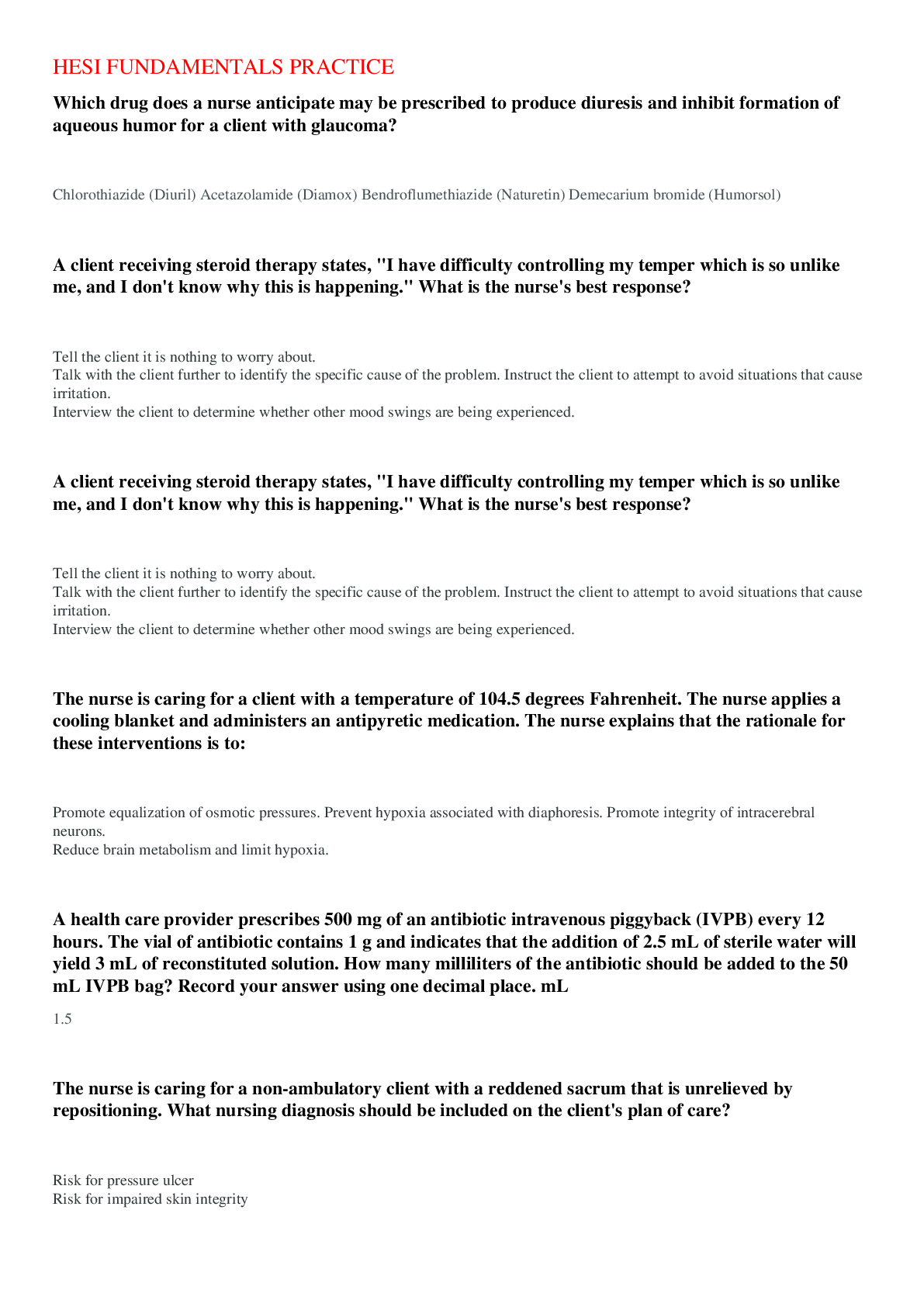
Reviews( 0 )
Document information
Connected school, study & course
About the document
Uploaded On
Apr 07, 2021
Number of pages
25
Written in
Additional information
This document has been written for:
Uploaded
Apr 07, 2021
Downloads
0
Views
274

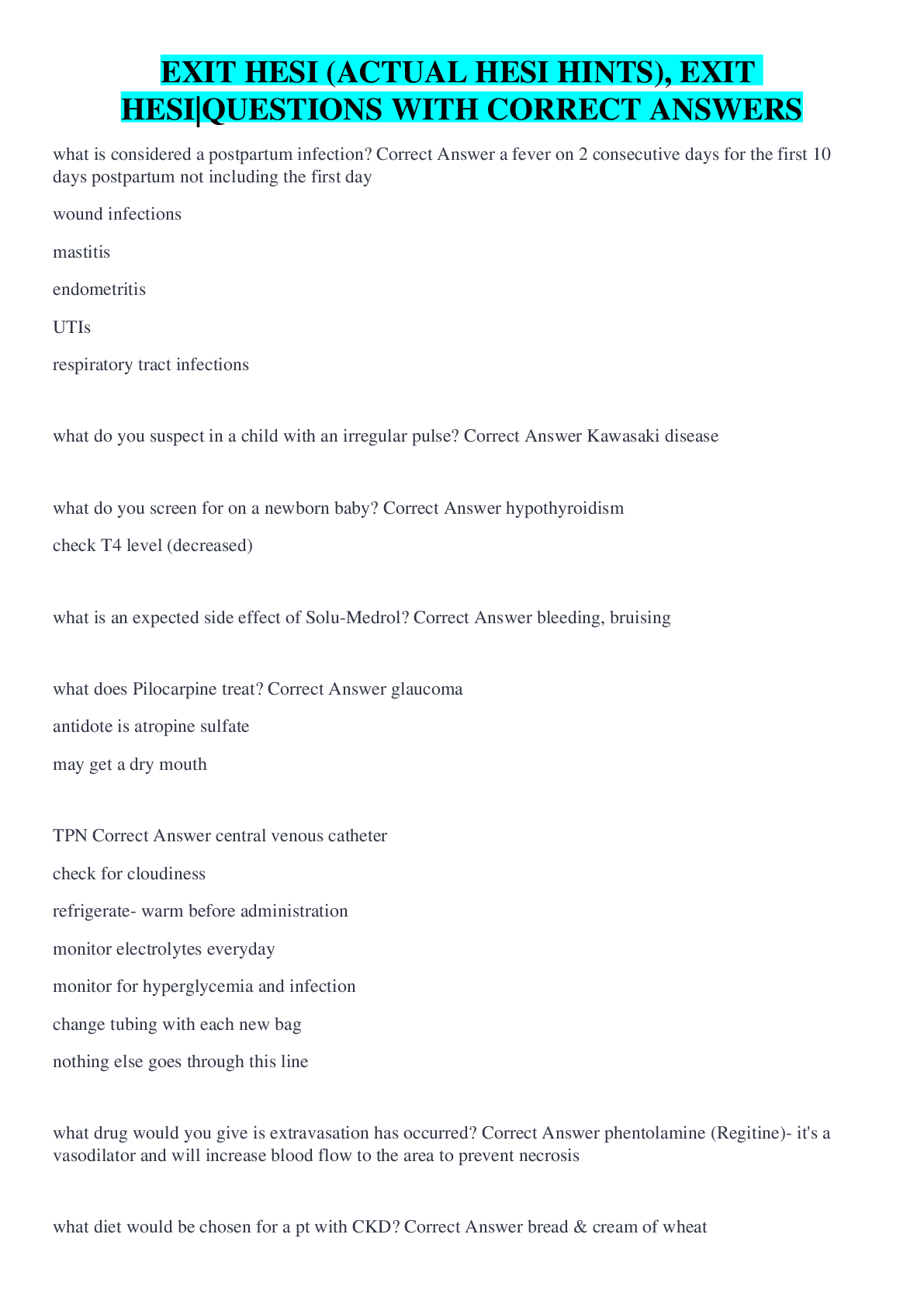
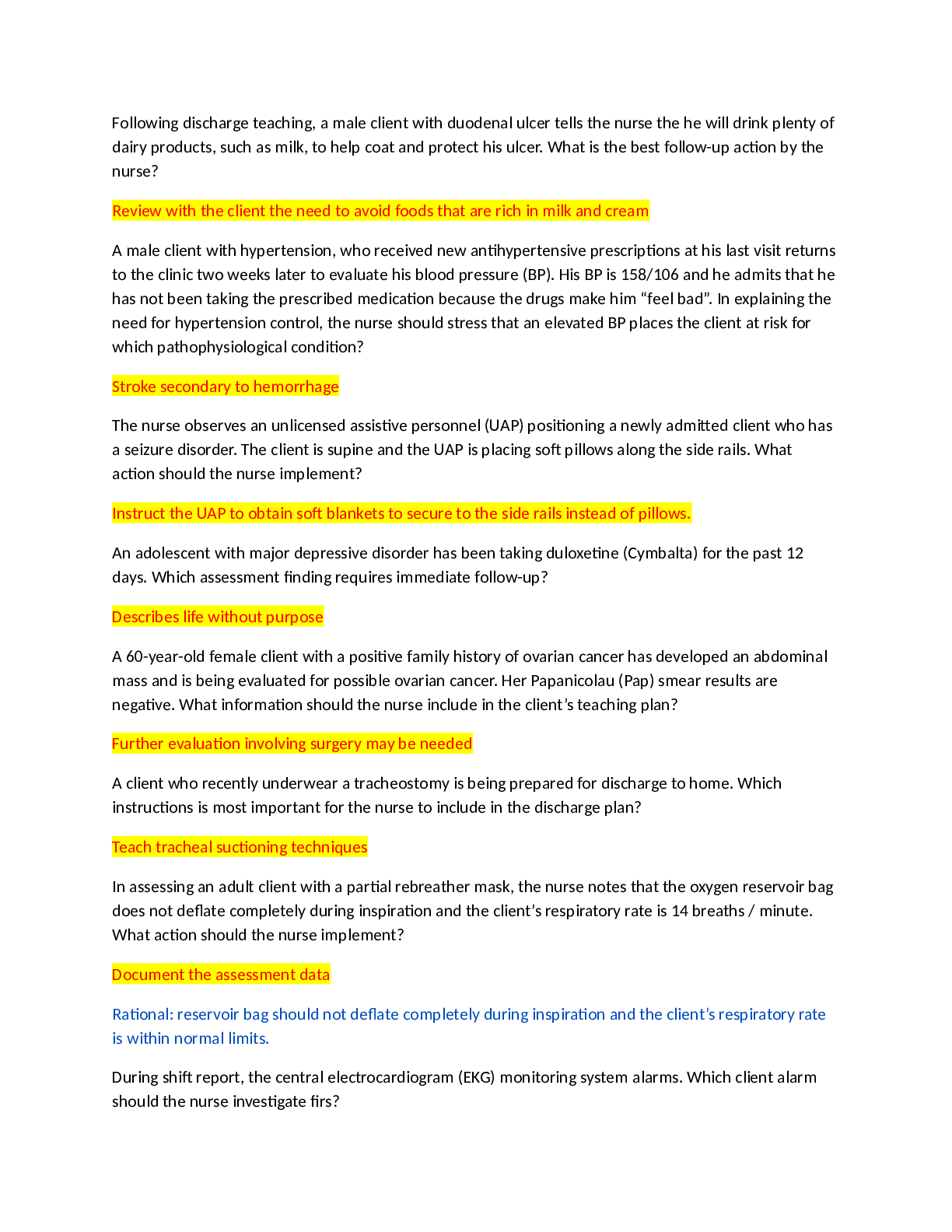

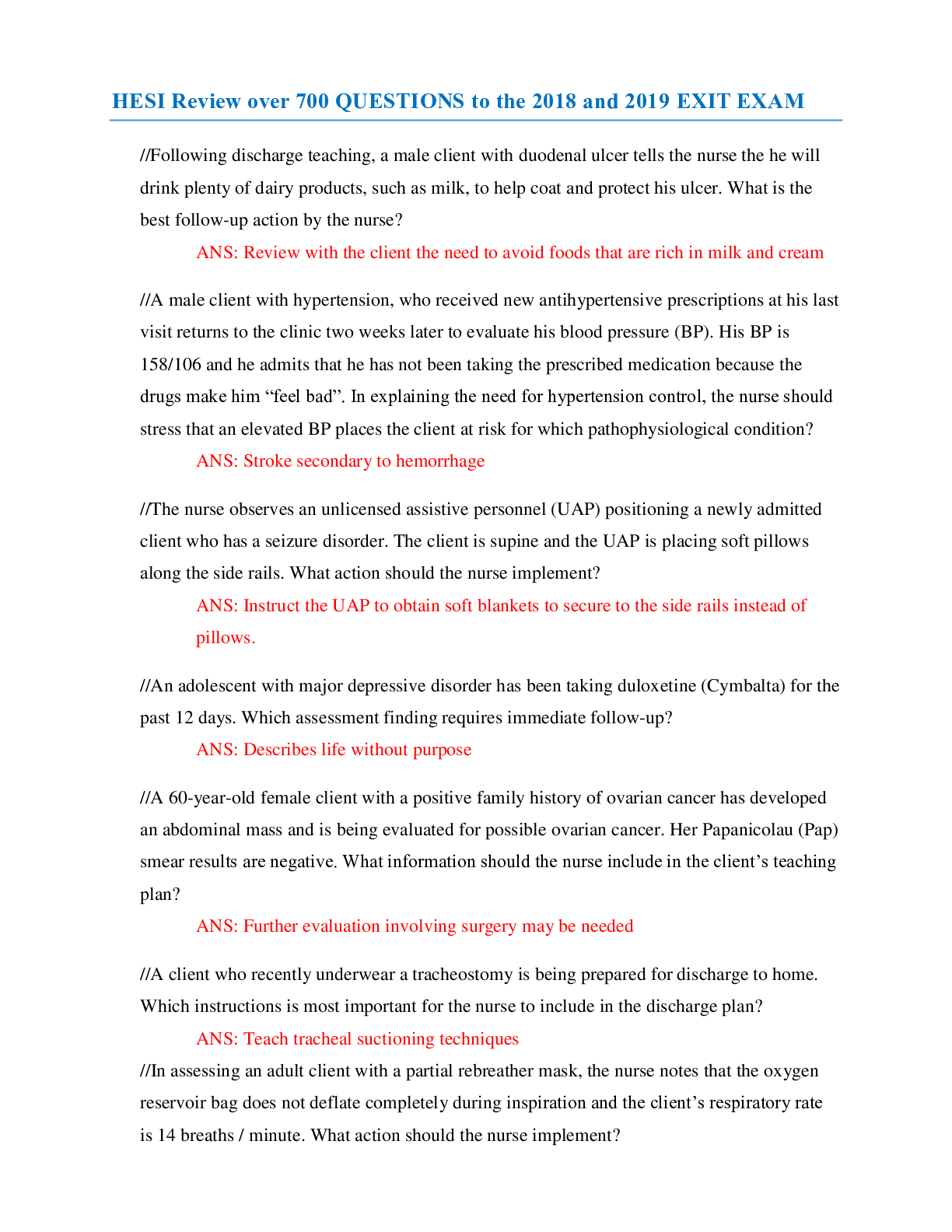
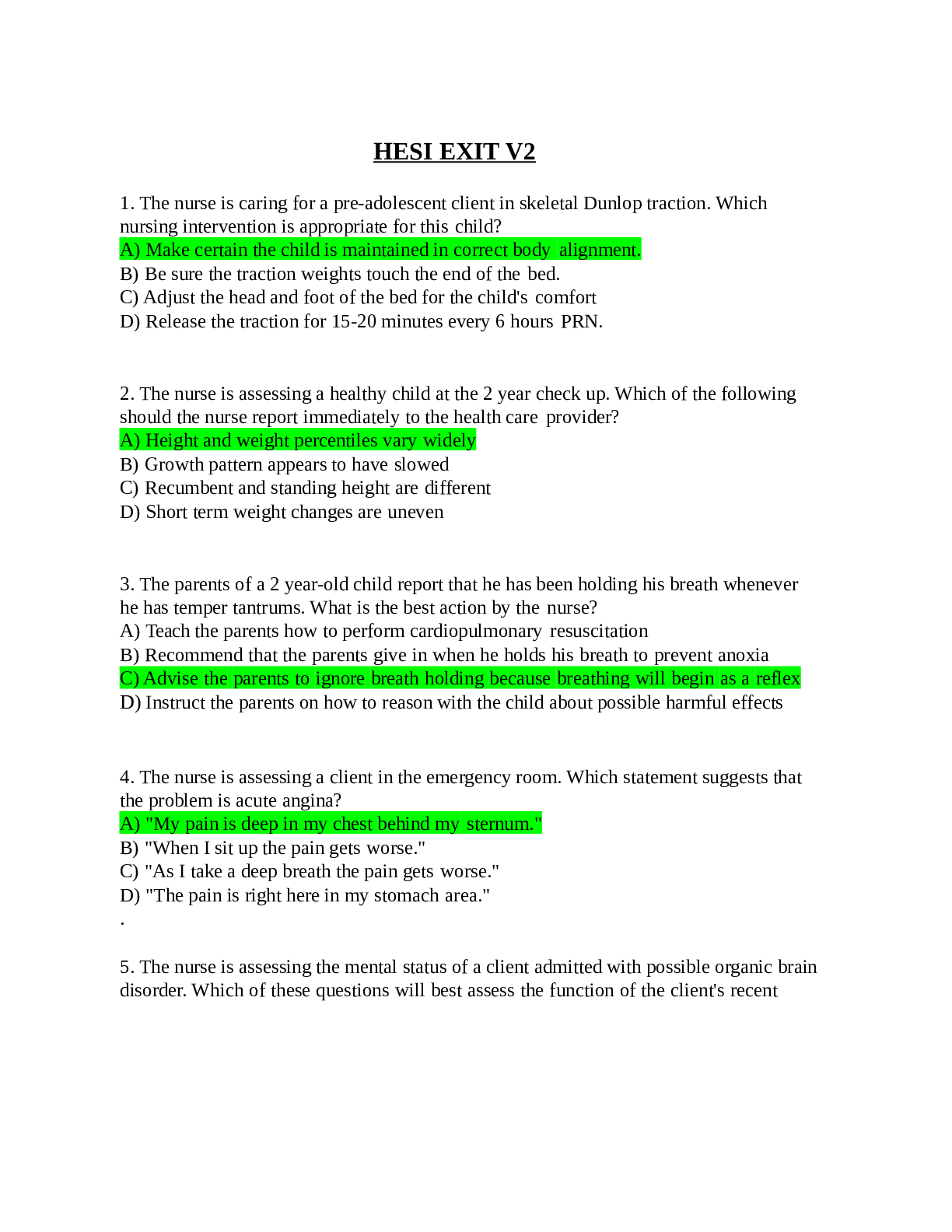
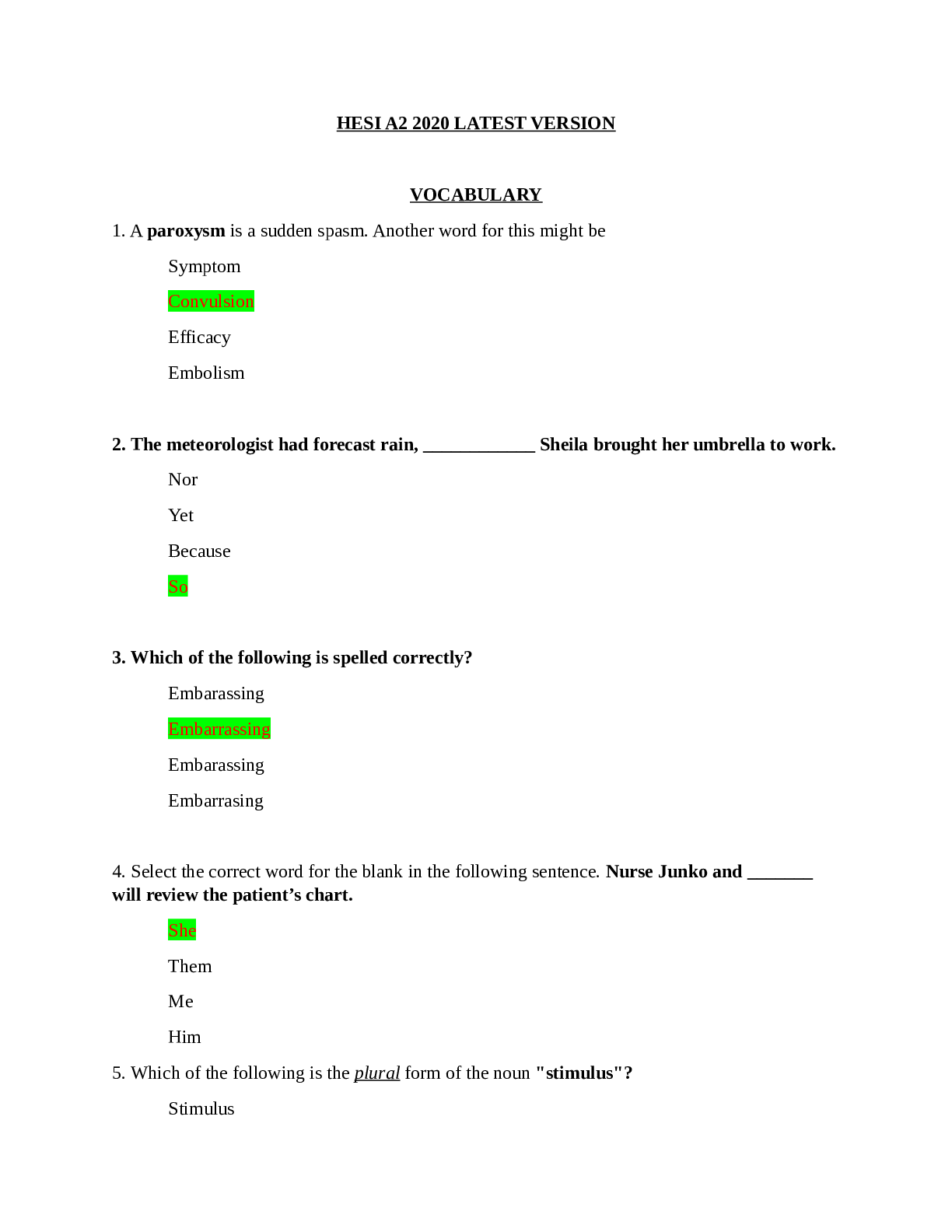
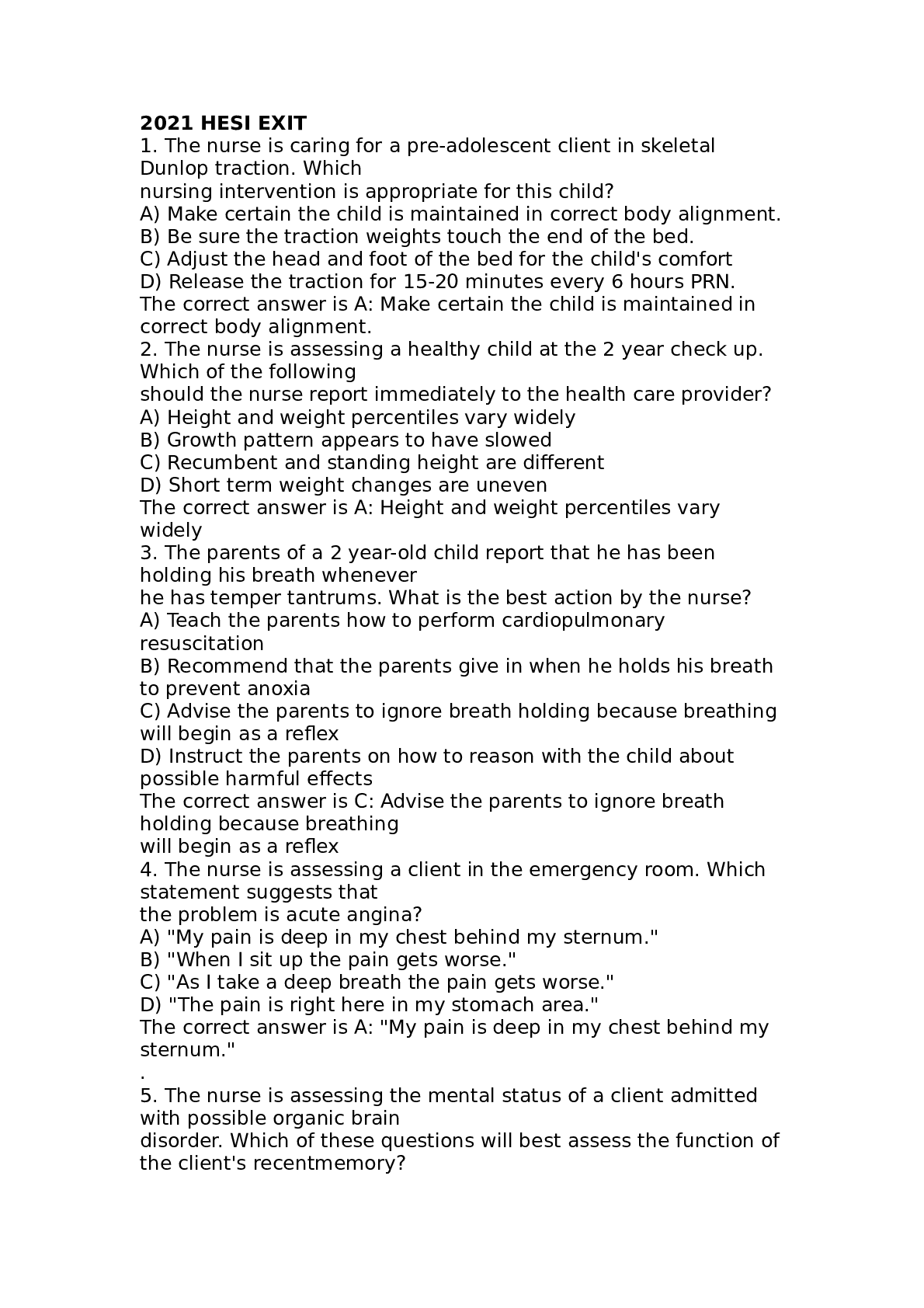
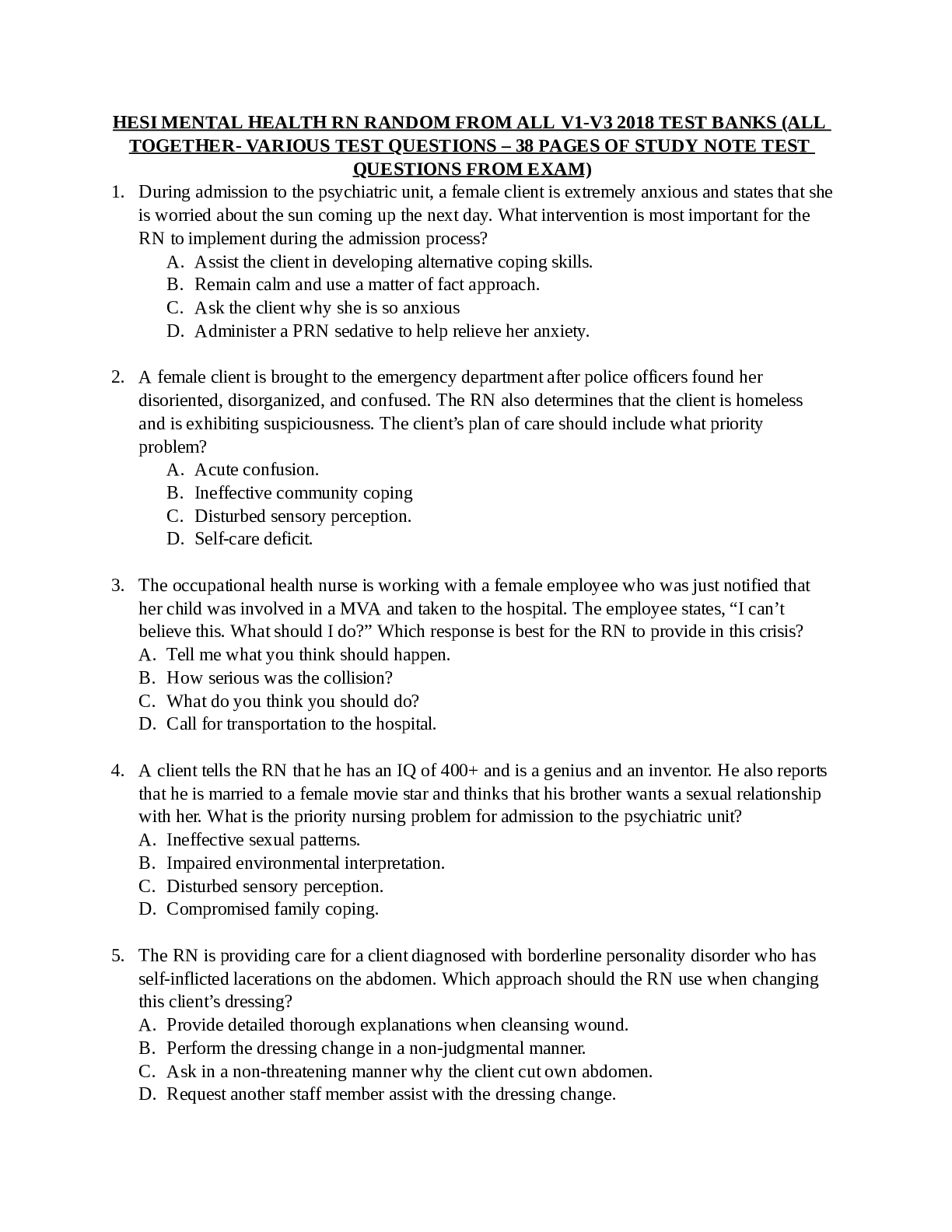

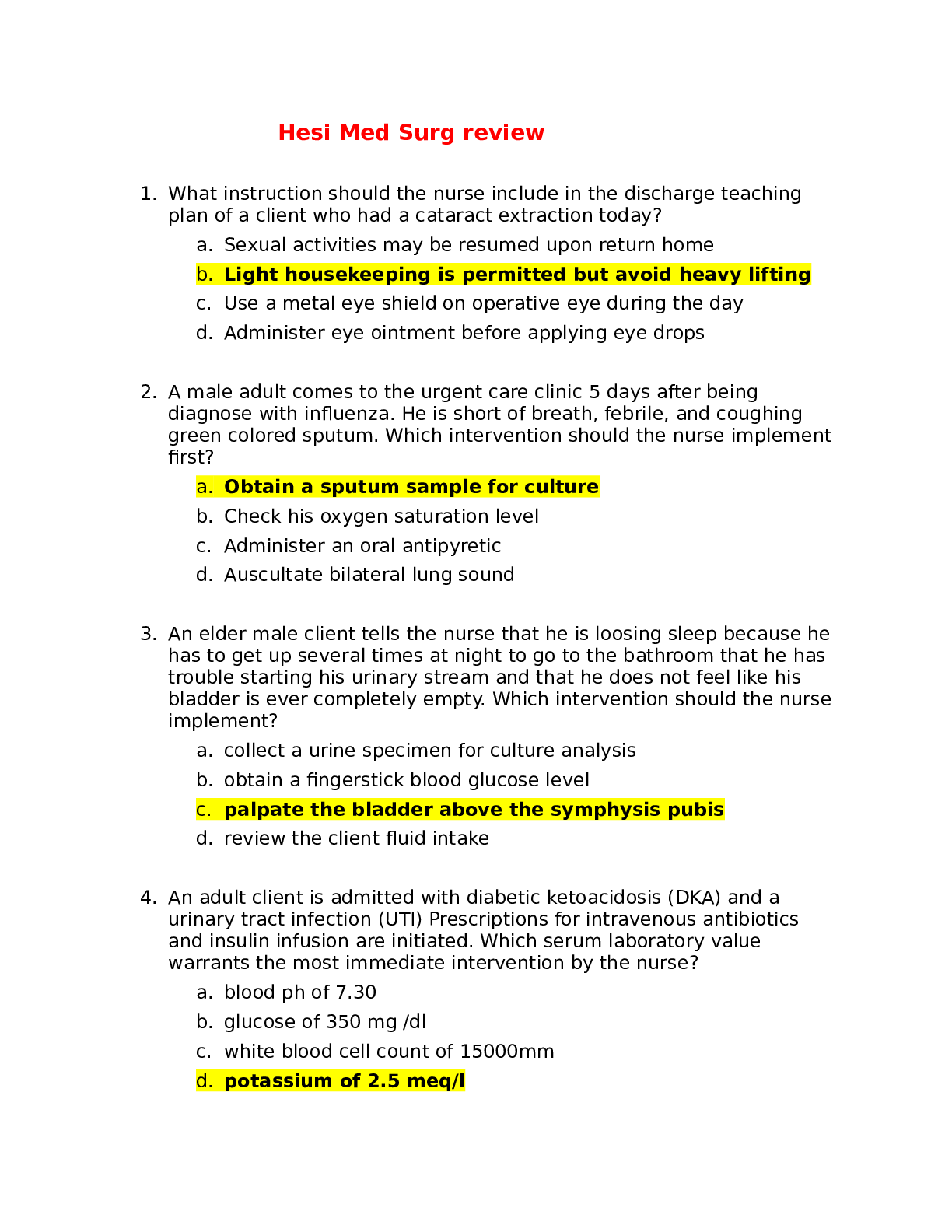

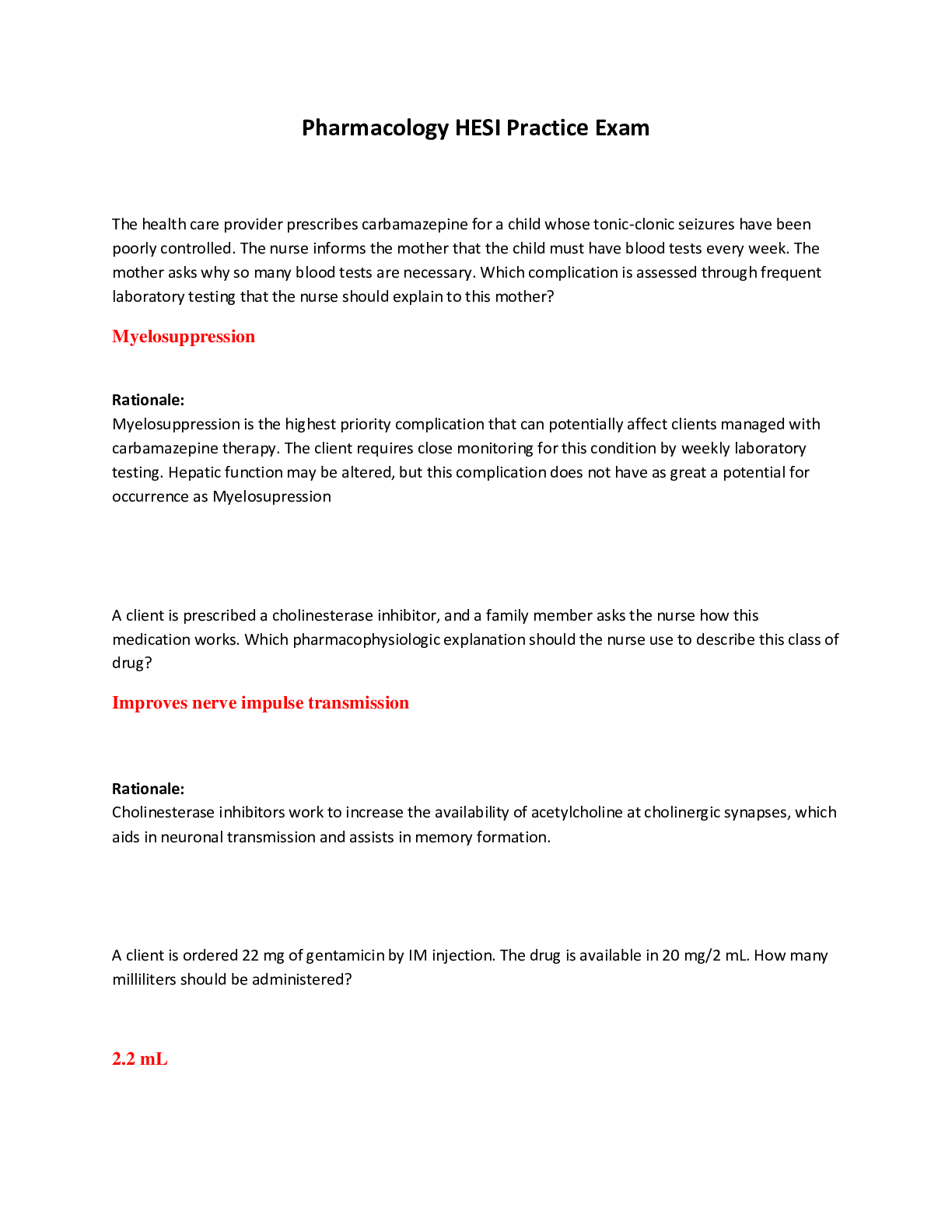
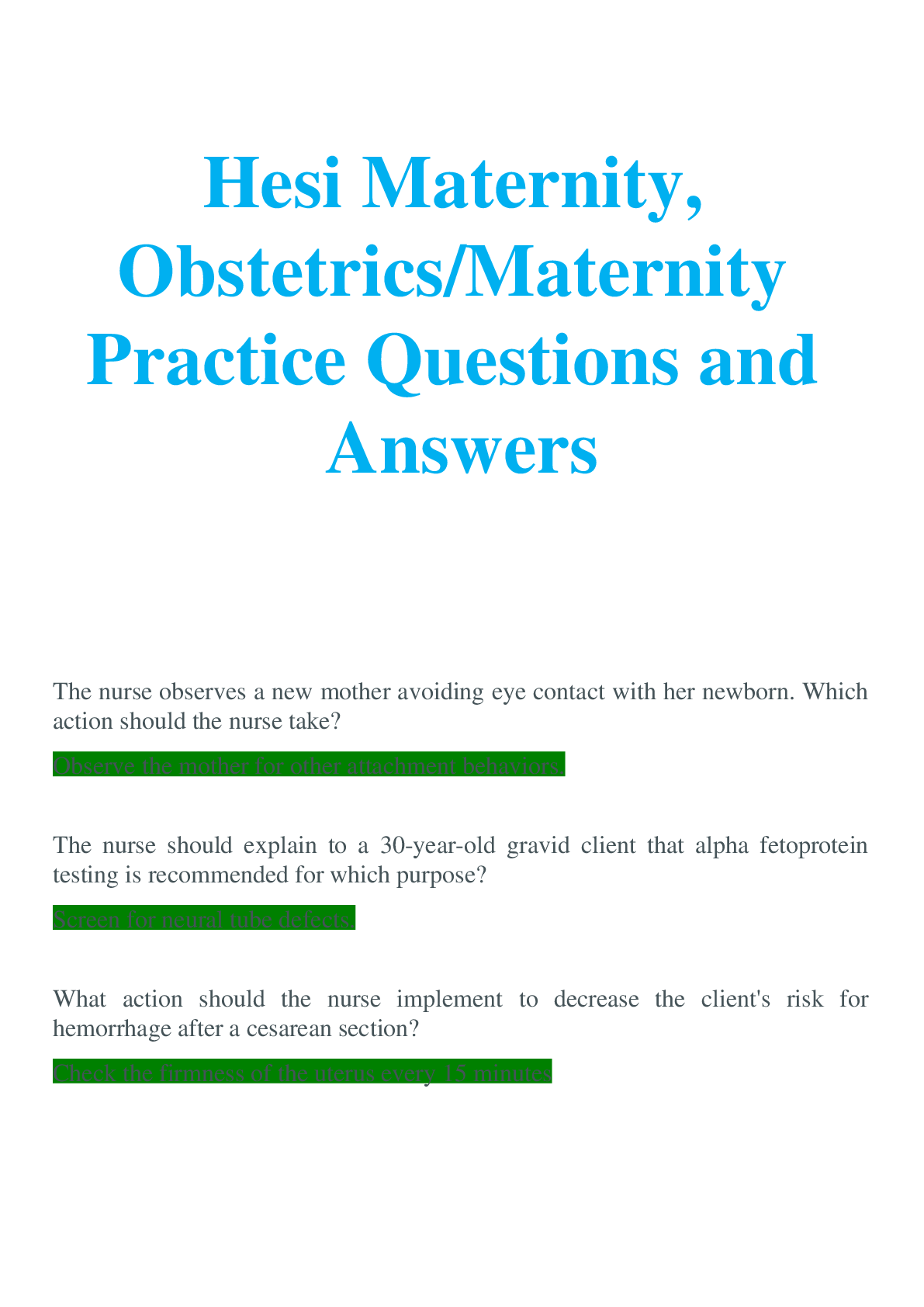

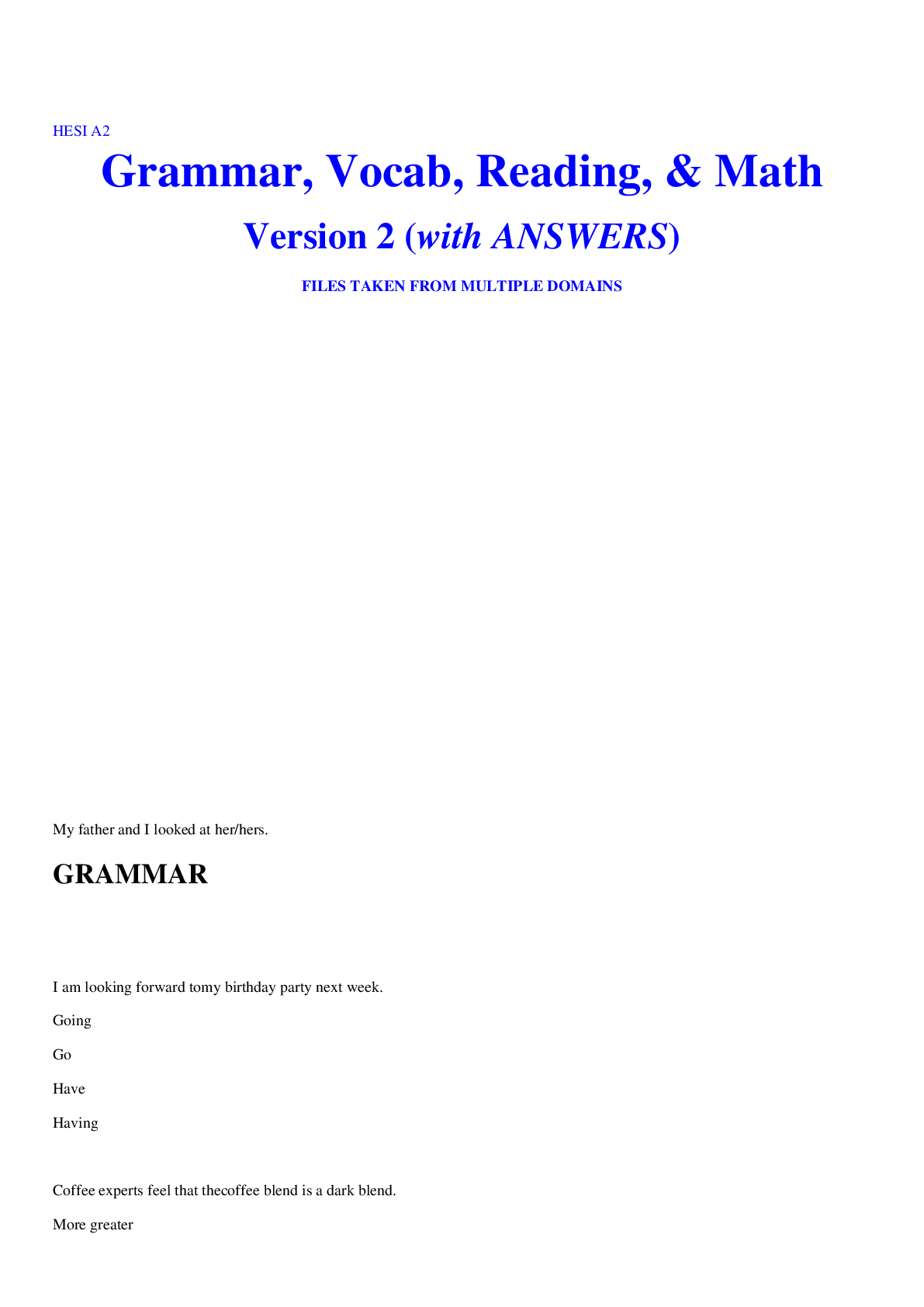
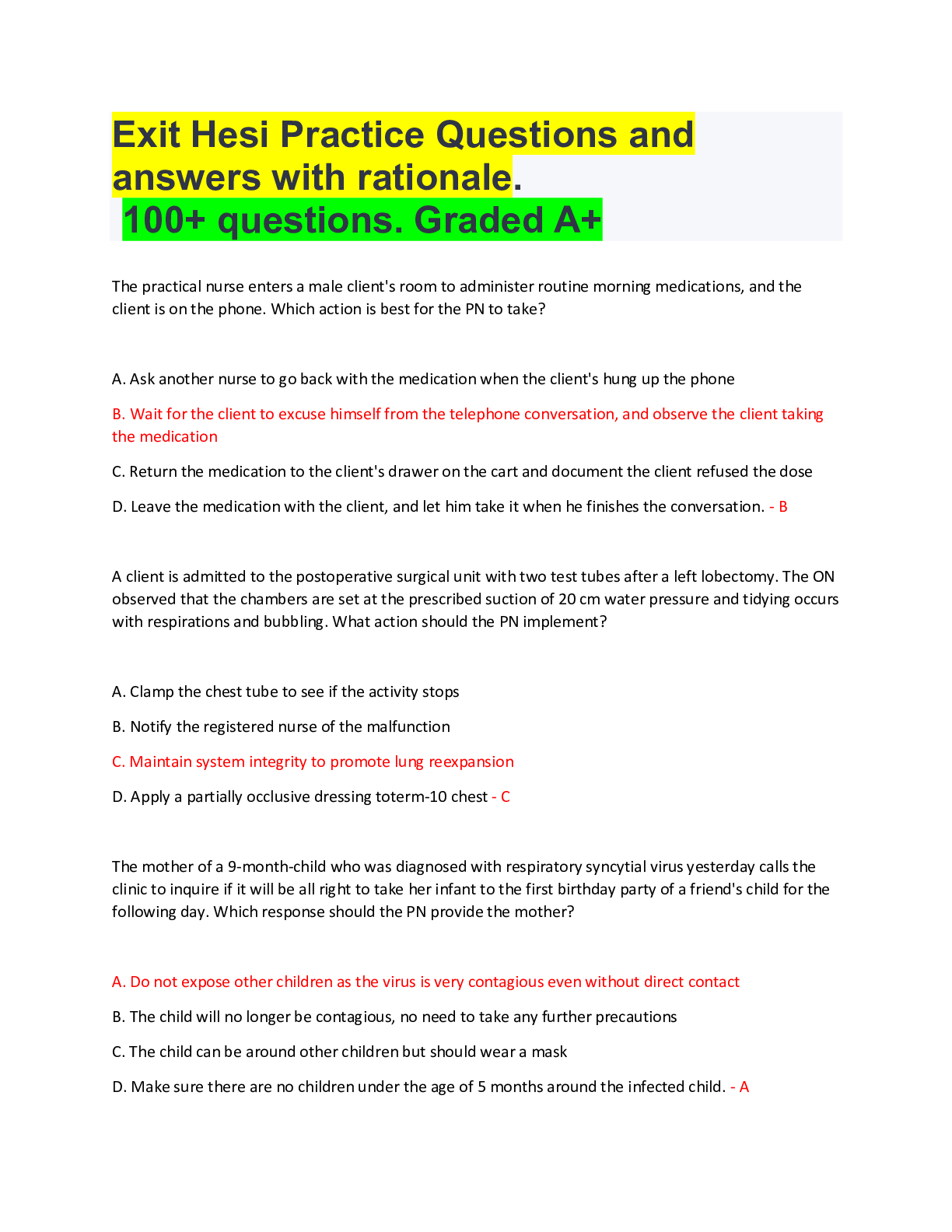
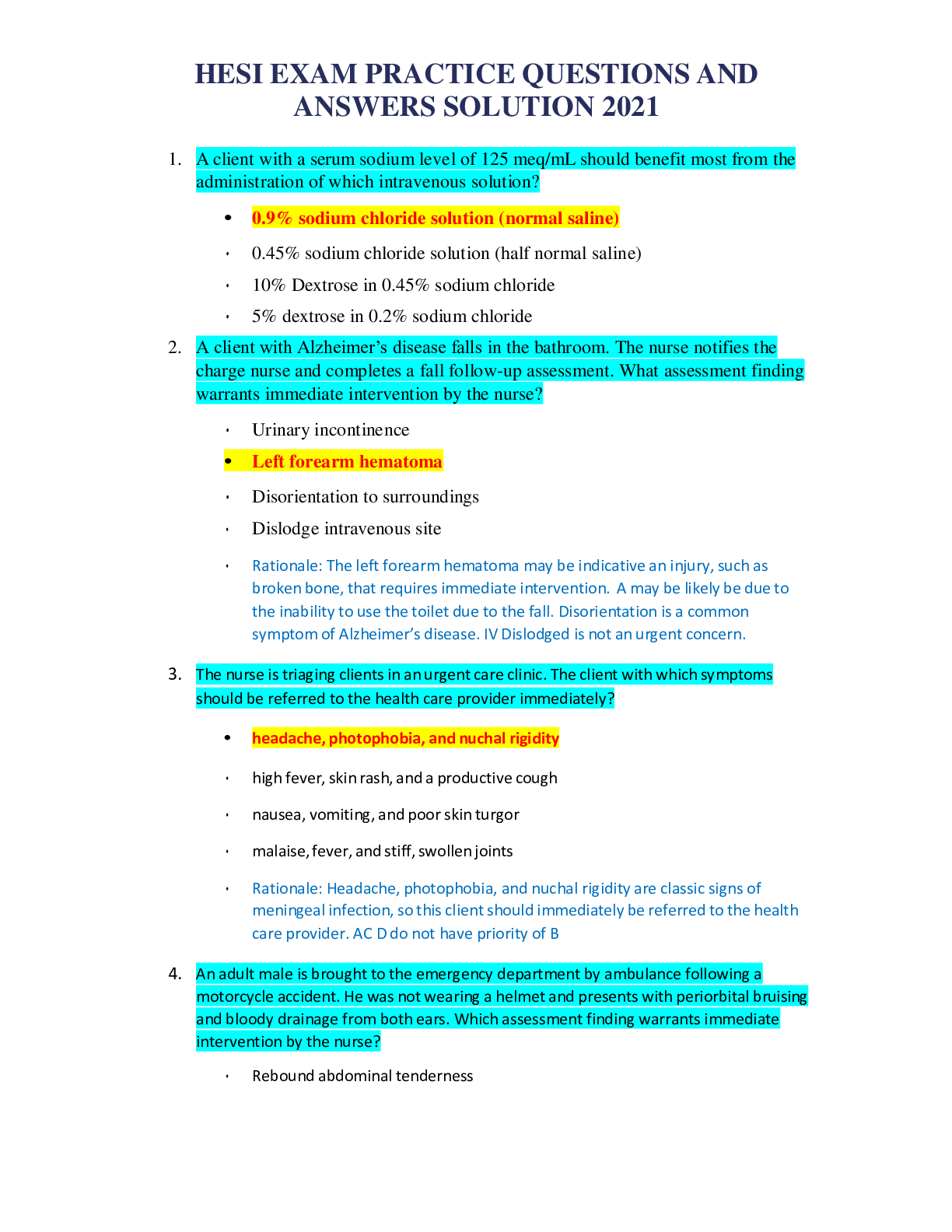
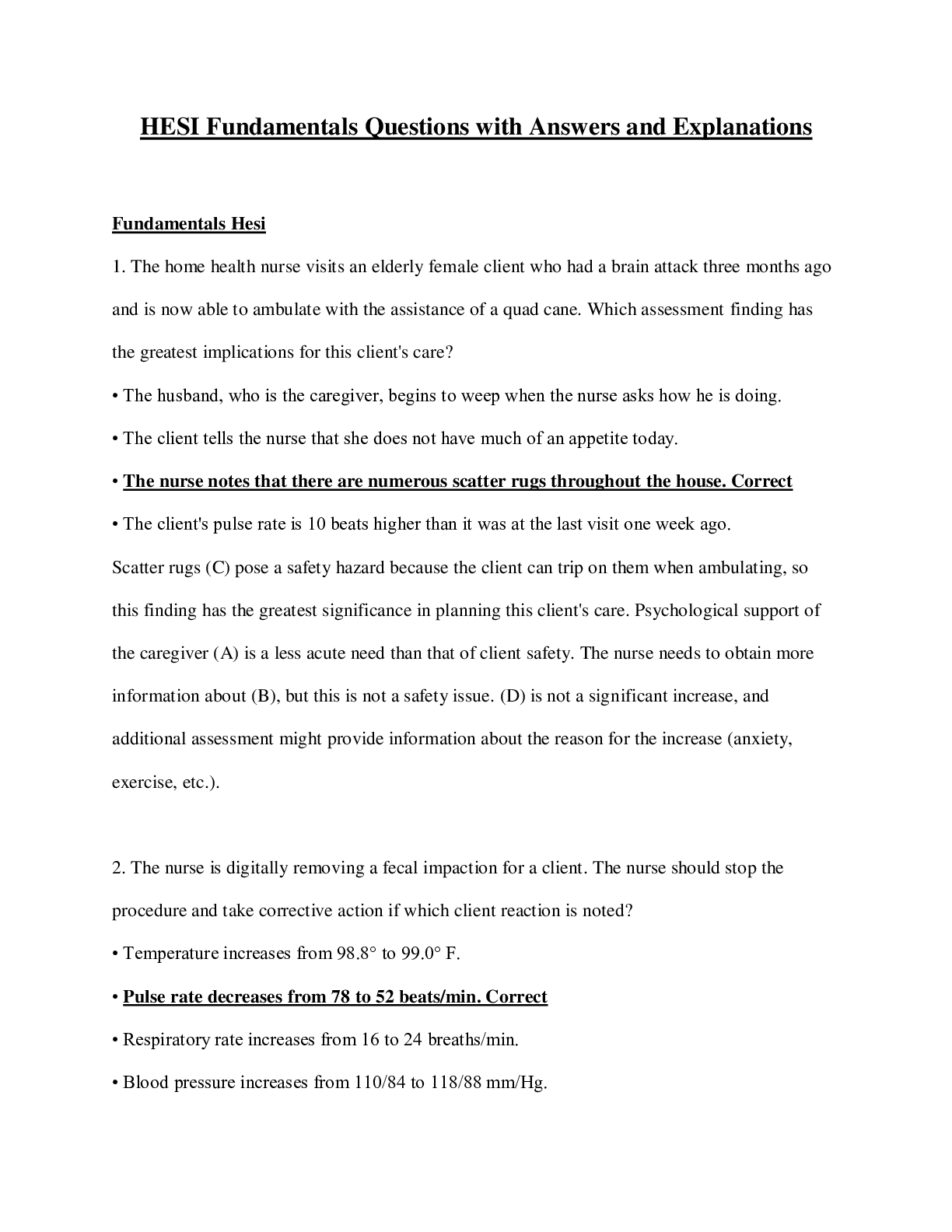
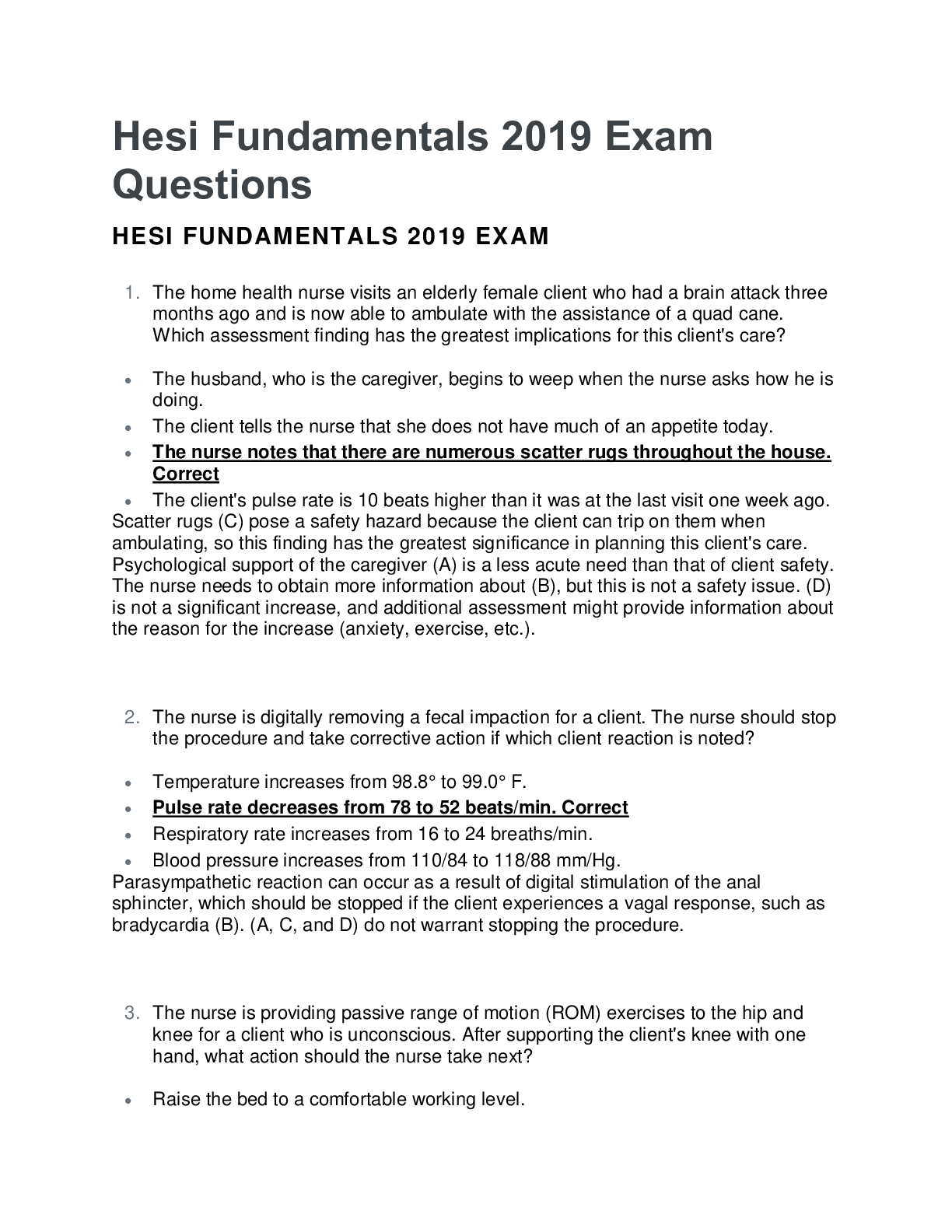
.png)
.png)
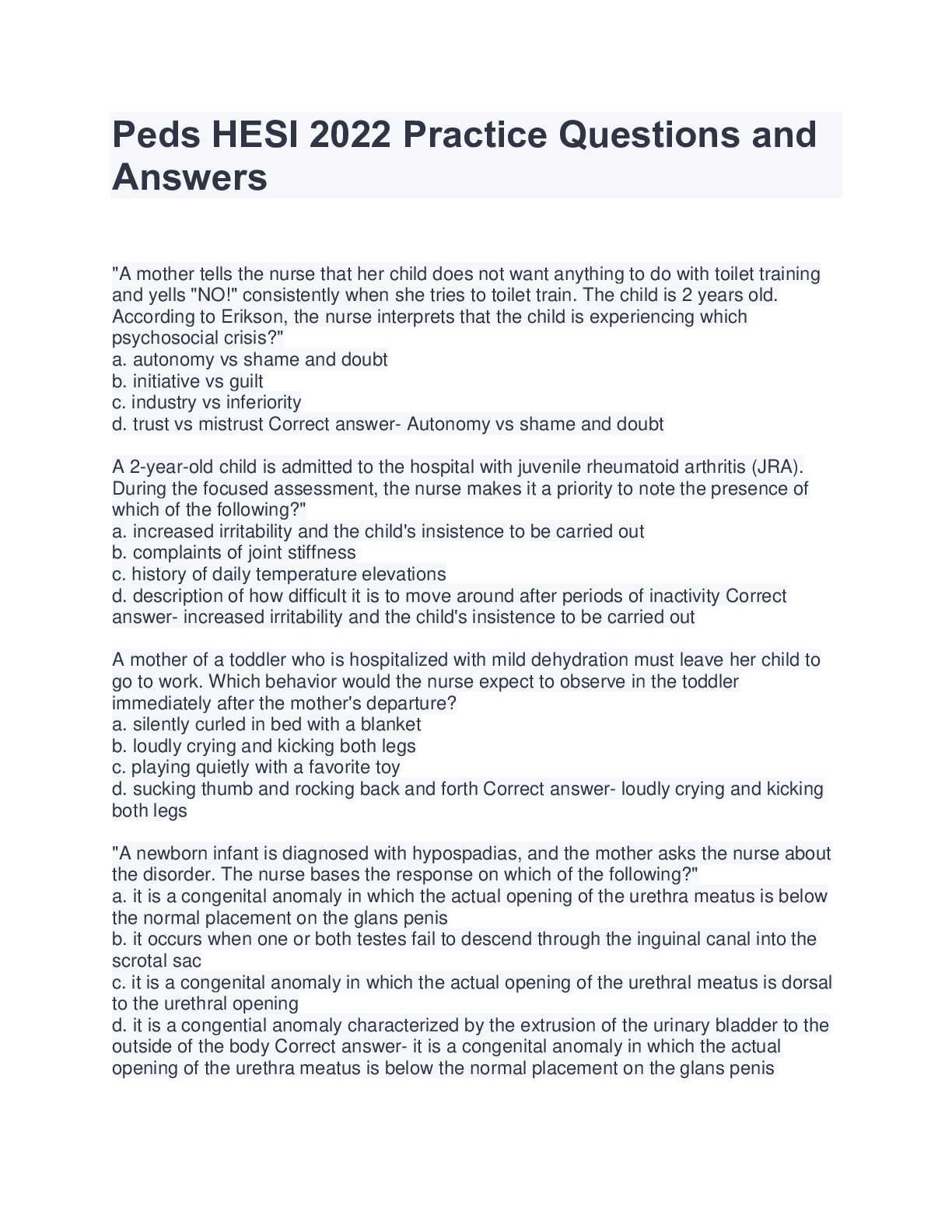
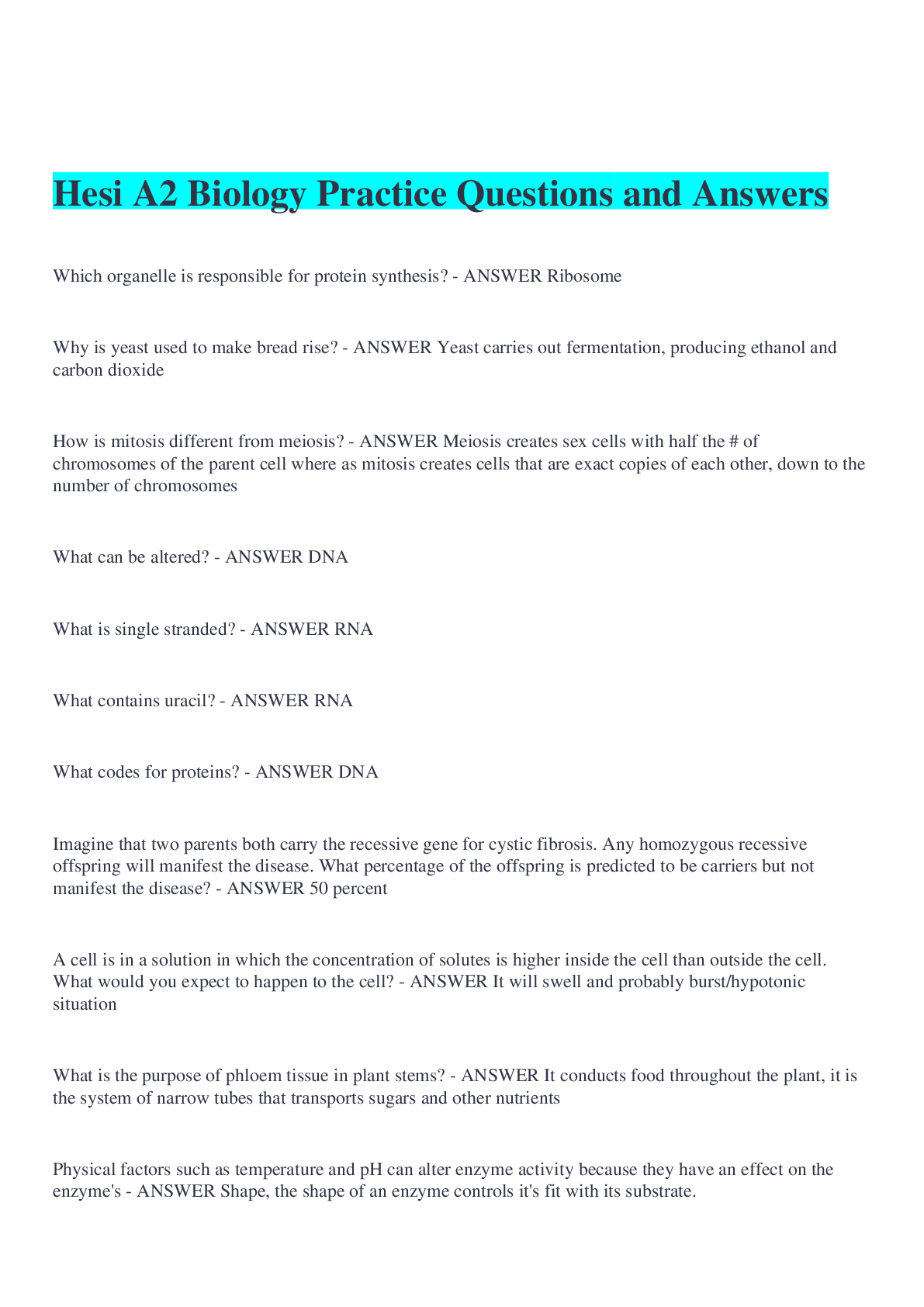
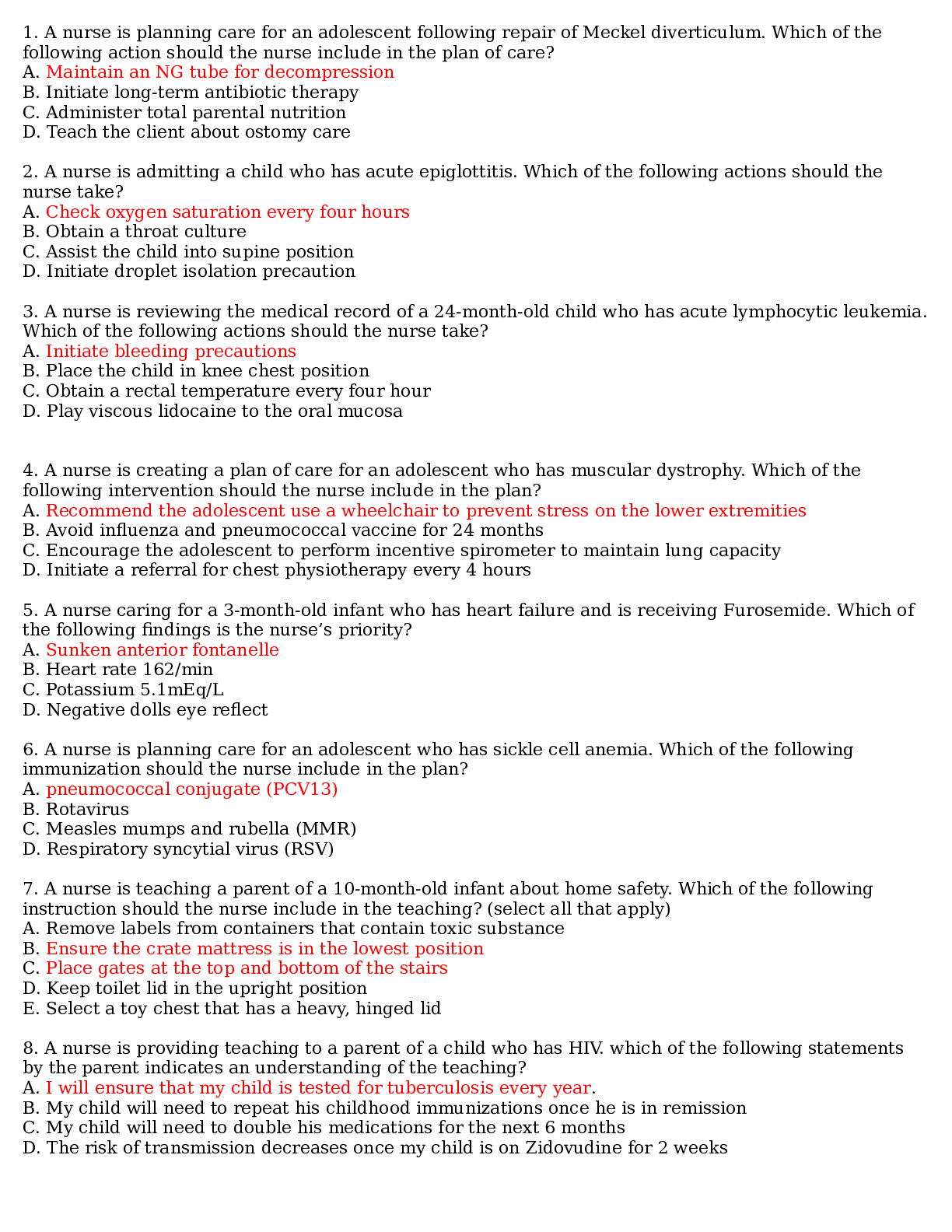

.png)
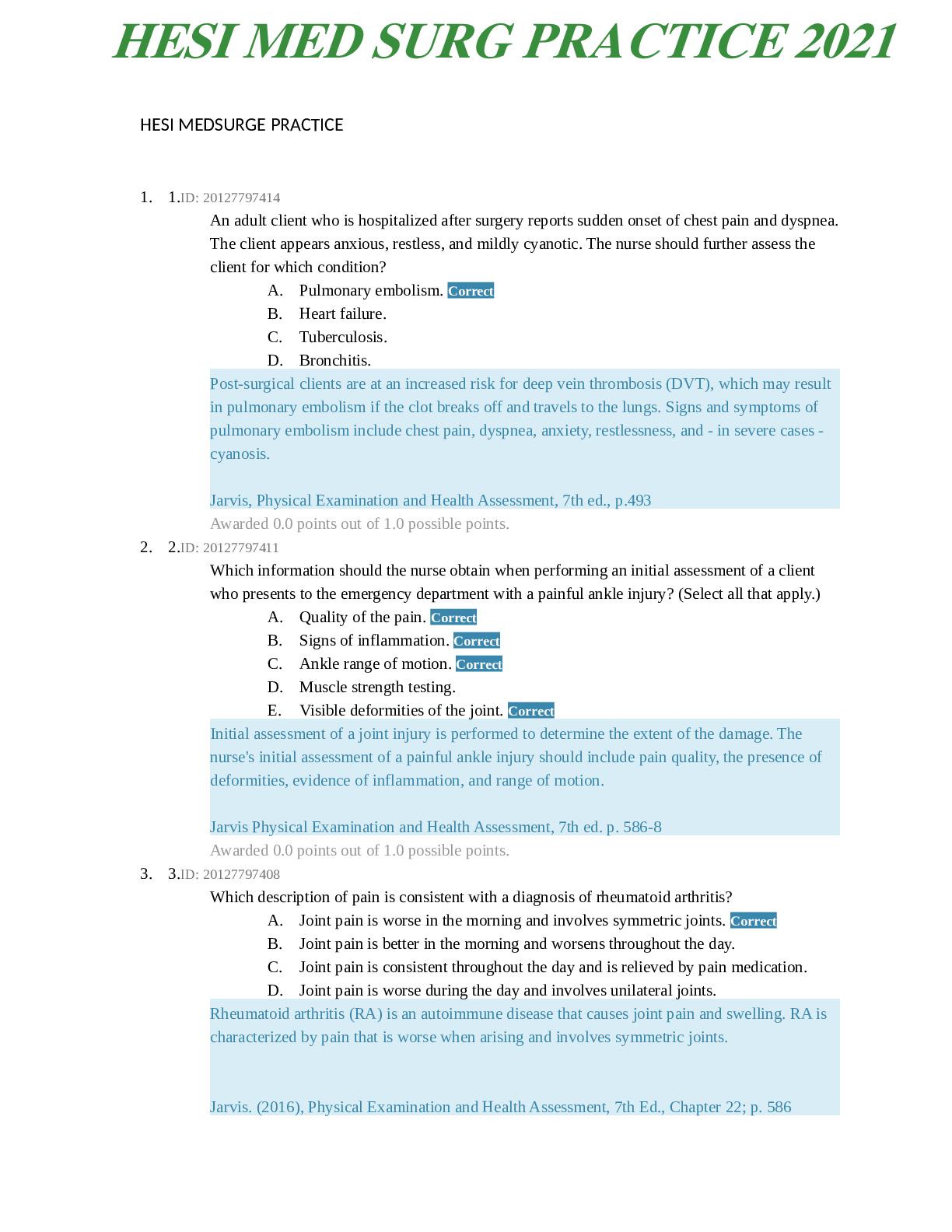
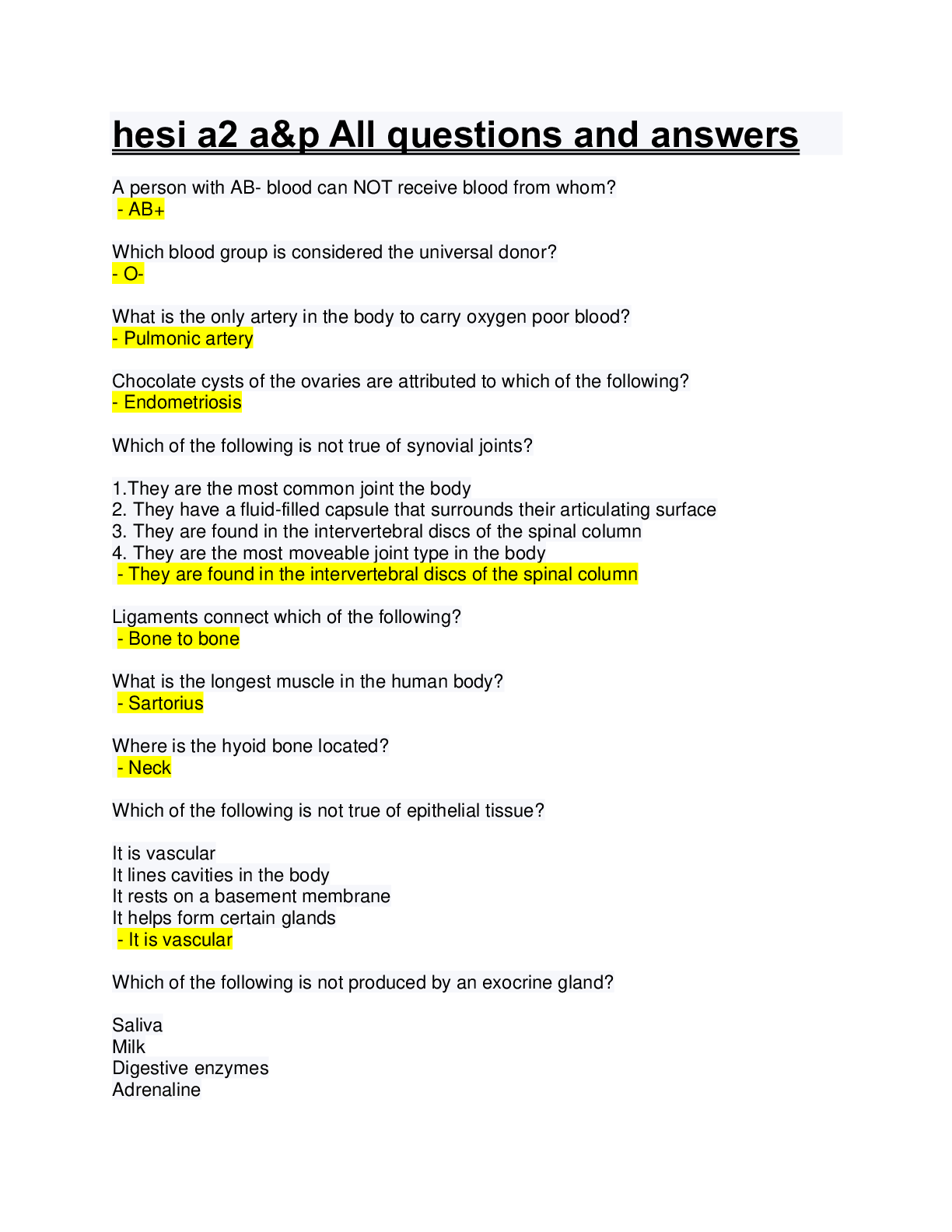
.png)
